We managed to get through the night without tripping over the mosquito netting. It wasn’t warm when we awoke, but not as chilly as it had been in Sweetwaters. The guest information packet on our desk had advised that because each tent was equipped with an on-demand water heater, it might take five to ten minutes before hot water reached the shower, so it was a nice surprise to see steam swirling beyond the glass door within about two minutes.
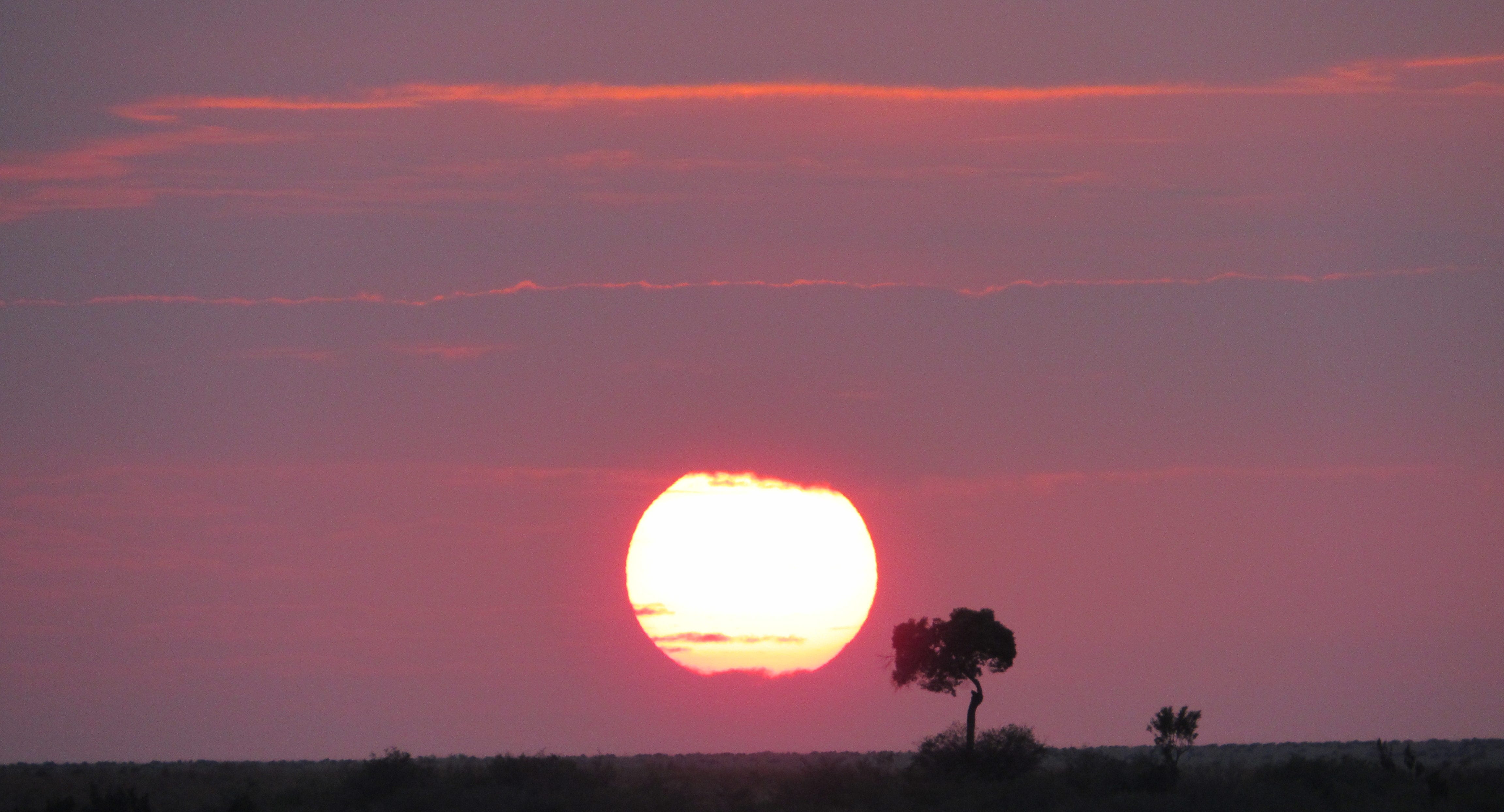
Sunrise in the Maasai Mara
This morning we rode into the dark with Eva, Barry, and Jim, with Edwin at the wheel. The clouds that had rained on us a little last night were still hanging low, but now were streaked with pink and orange as the sun rose. Each day during this safari we have been amazed at how quickly the sun reaches full orb as it springs into the sky, rising at a 90° angle to the horizon from our equatorial vantage point.
Now in the midst of their annual migration from the Serengeti, wildebeests are everywhere, sprinkled across the golden landscape like chocolate chips in a vast pan of blond brownies. Sometimes they are mixed with herds of zebras, whose high-pitched whinnies sound like chirping birds, or yappy little dogs. The wildebeests moo like cows.
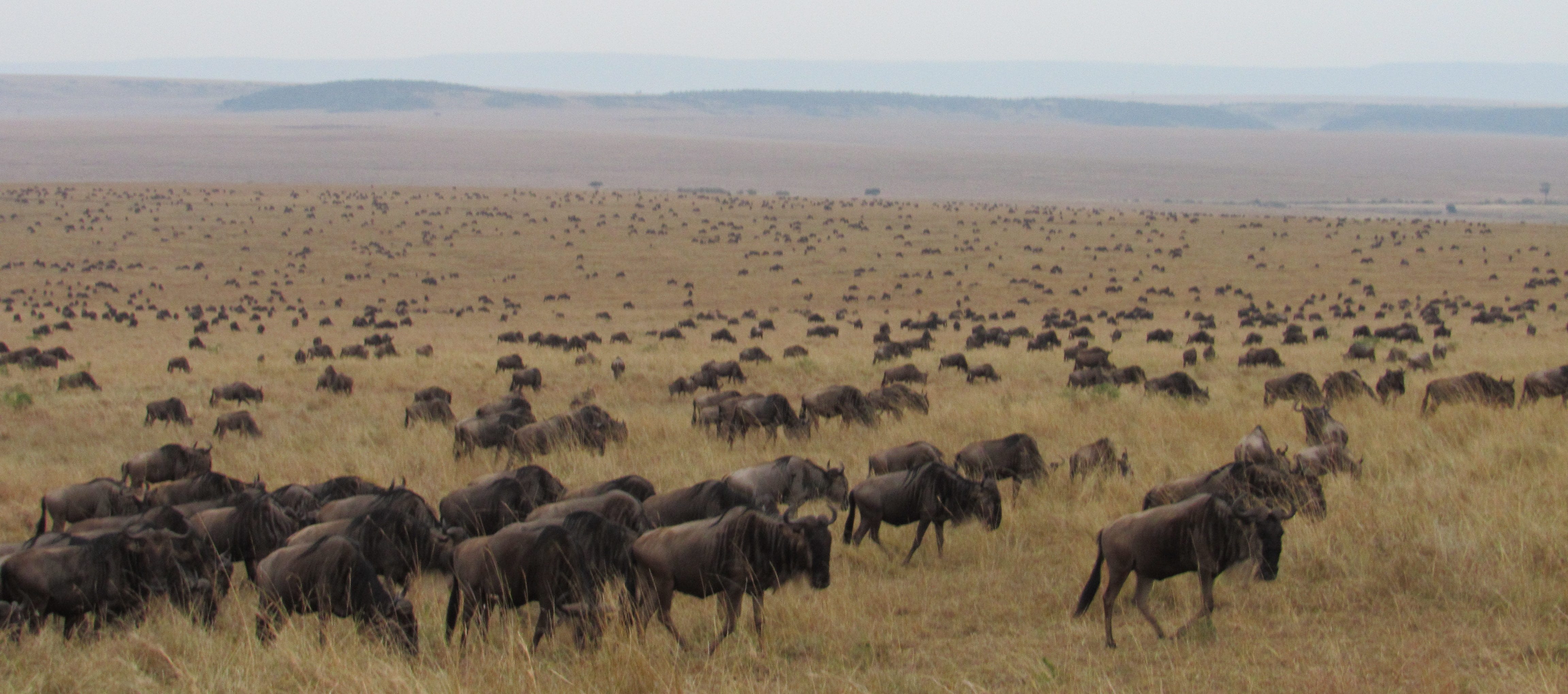
Migrating wildebeests
We are learning to adjust our mental images of “wildebeest migration” and “crossing the Mara,” formed during the nine months we spent anticipating this trip. Both Nancy and Michael had pictured millions of wildebeests moving en masse, all gathering on the bluffs above the Mara River until the day when the urge to cross became too unbearable. Then they would plunge, all of them, lemming-like, regardless of how steep the cliff or unsure the footing. The animals that survived the drop and didn’t get trampled in the stampede would scramble up the bank to greener pastures on the other side of the river. And then it would be over.
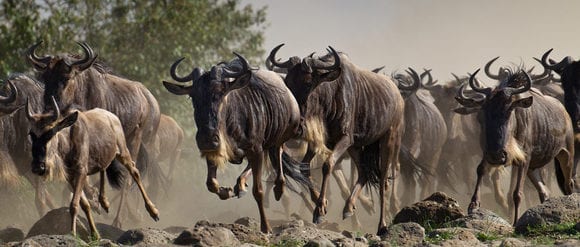
Stampeding wildebeests (not our own photo)
Well, that’s sort of what happens, but not all at once, as we had imagined. There are indeed more than a million wildebeests moving north from the Serengeti into the Maasai Mara, but they come gradually: a few thousand here, a few thousand there, over a period of weeks from June to October. Thus there is not one momentous crossing of the Mara, but many smaller crossings of the several rivers that snake through the region. The reality of the migration may not be as epic as what we initially pictured, but it’s still pretty impressive. During the journey, the wildebeests mate and give birth. Half a million calves will drop from their mothers’ wombs, totter onto their spindly legs, and ten minutes later will be ready to follow the migrating herd. Meanwhile, a quarter-million wildebeests will die during these months, pulled down by predators, wounded by rivals, or trampled by heedless companions. If they can avoid the common fates, they may live as long as forty years.
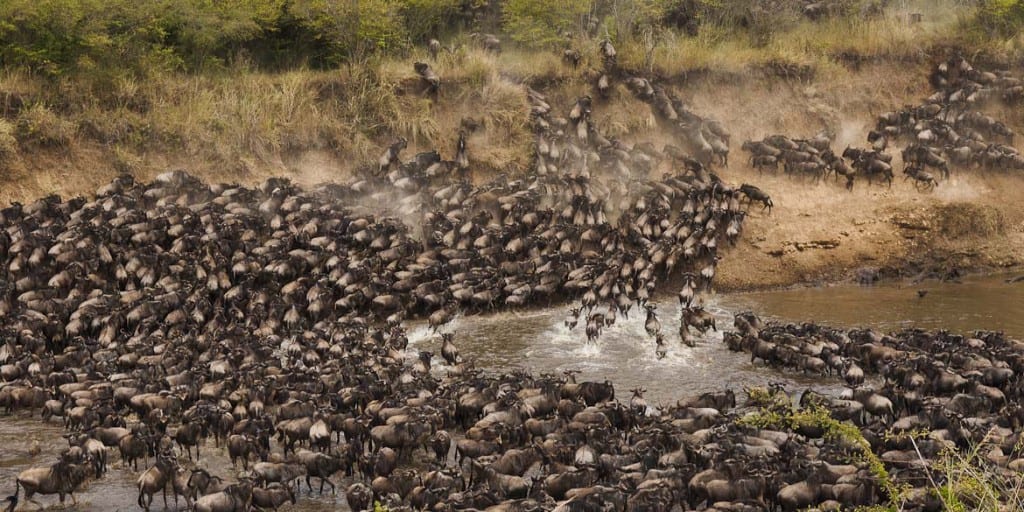
Wildebeests crossing a river (also not our own photo)
Because wildebeests travel in herds and aren’t capable of rational thinking, they are subject to the same type of crowd mentality that sometimes drives human beings–soccer fans, say–to crush each other in a frenzied attempt to get somewhere else in a hurry. Wildebeest stampedes may be triggered by one skittish animal who thinks that shadow unexpectedly appearing from behind is a cheetah. Maybe that shadow is a cheetah; whatever, suddenly the wildebeests take off running. If they scatter in different directions, eventually they will calm down and return to grazing; but if they happen to start galloping in the same direction, the momentum will build until every animal within sight has been caught up in the shockwave, overcome by the same nameless fear. So far, we’ve seen such stampedes only in the movies, but today we’ve watched plenty of witless individuals following leaders who have no idea that they are leading, let alone where they are leading, and can understand how a stampede might occur. However, most wildebeest mass movement is surprisingly orderly: a long line of dark brown creatures plodding single-file across the savannah like a pioneer wagon train on the prairie.
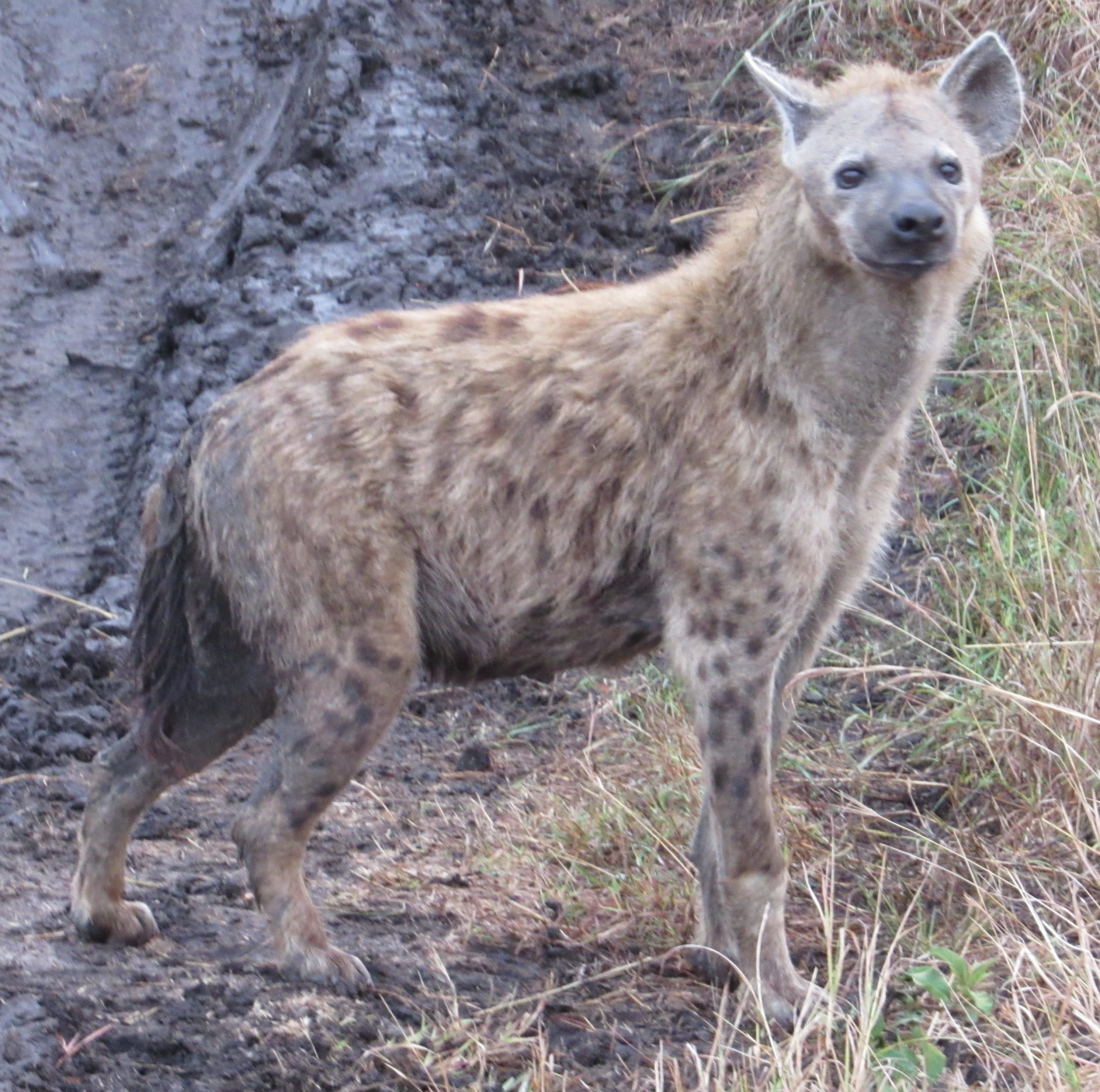
Spotted hyena
This morning we had hoped to see some wildebeests take the plunge into the Mara, but although a few lines were moving toward the river, none were doing so with any urgency.
The jackals and hyena pack we saw not far from a cluster of grazers must have stayed downwind because they didn’t seem to create much anxiety in the herd, either.
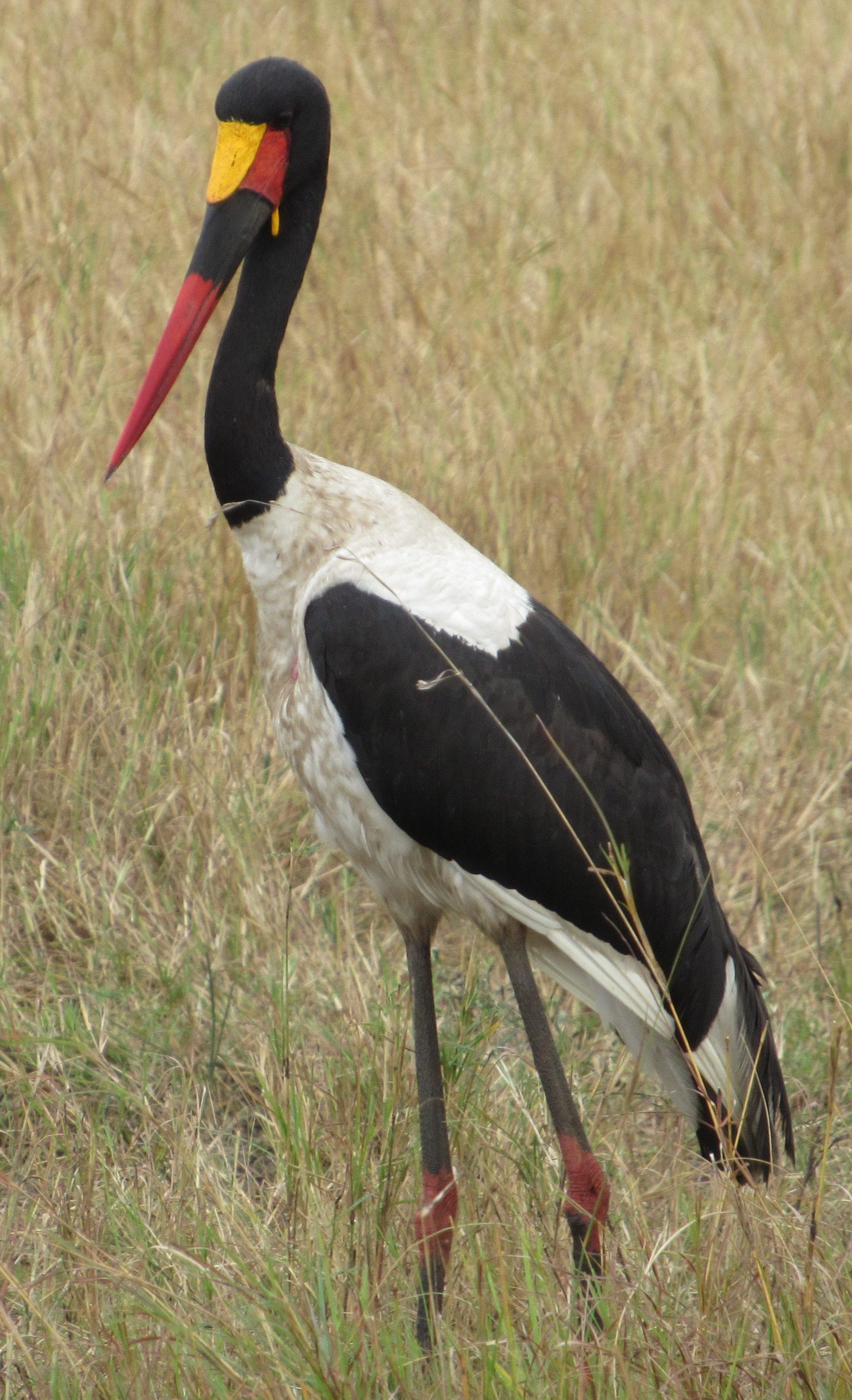
Saddle-backed stork
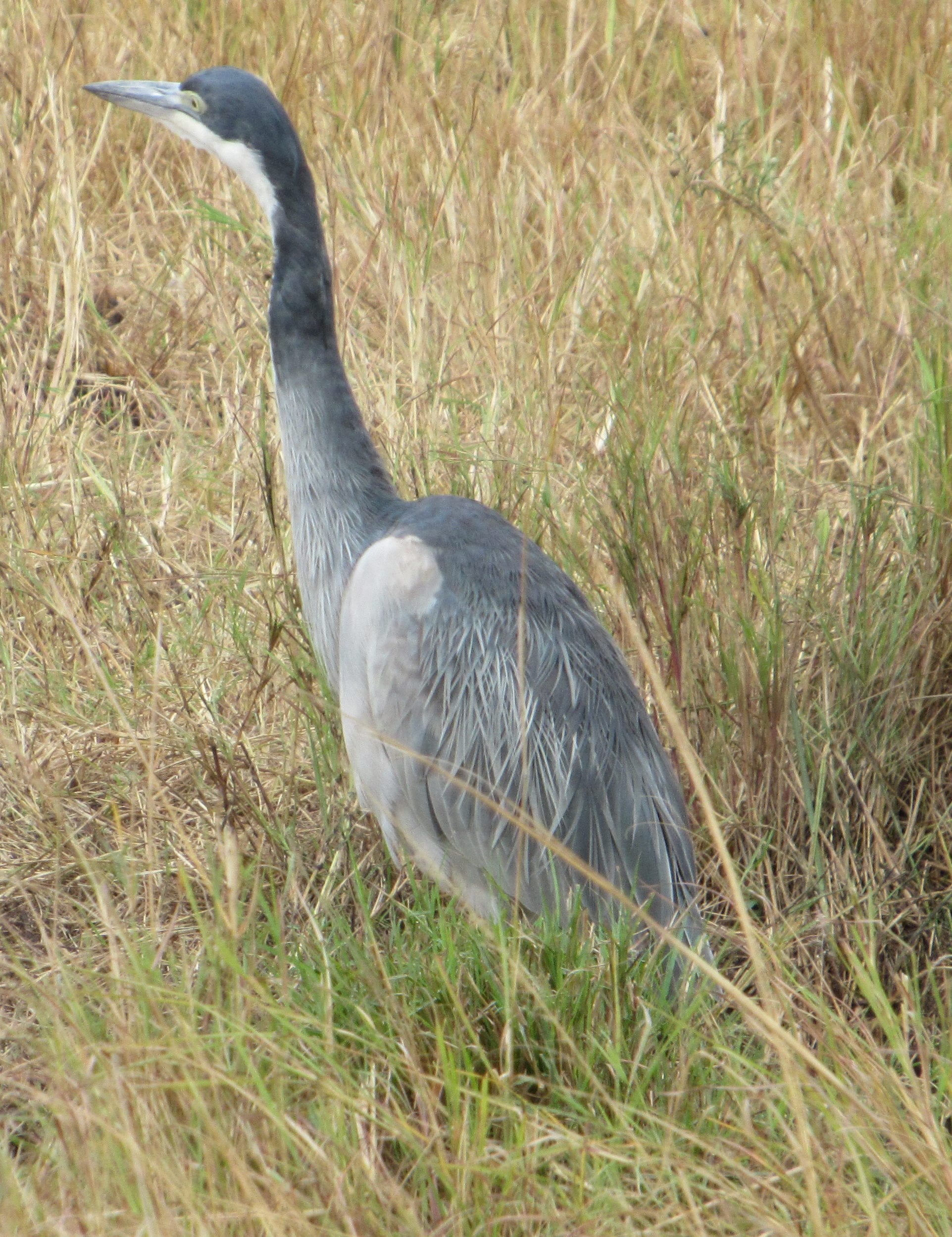
Grey heron

Choose the egg color of your preference
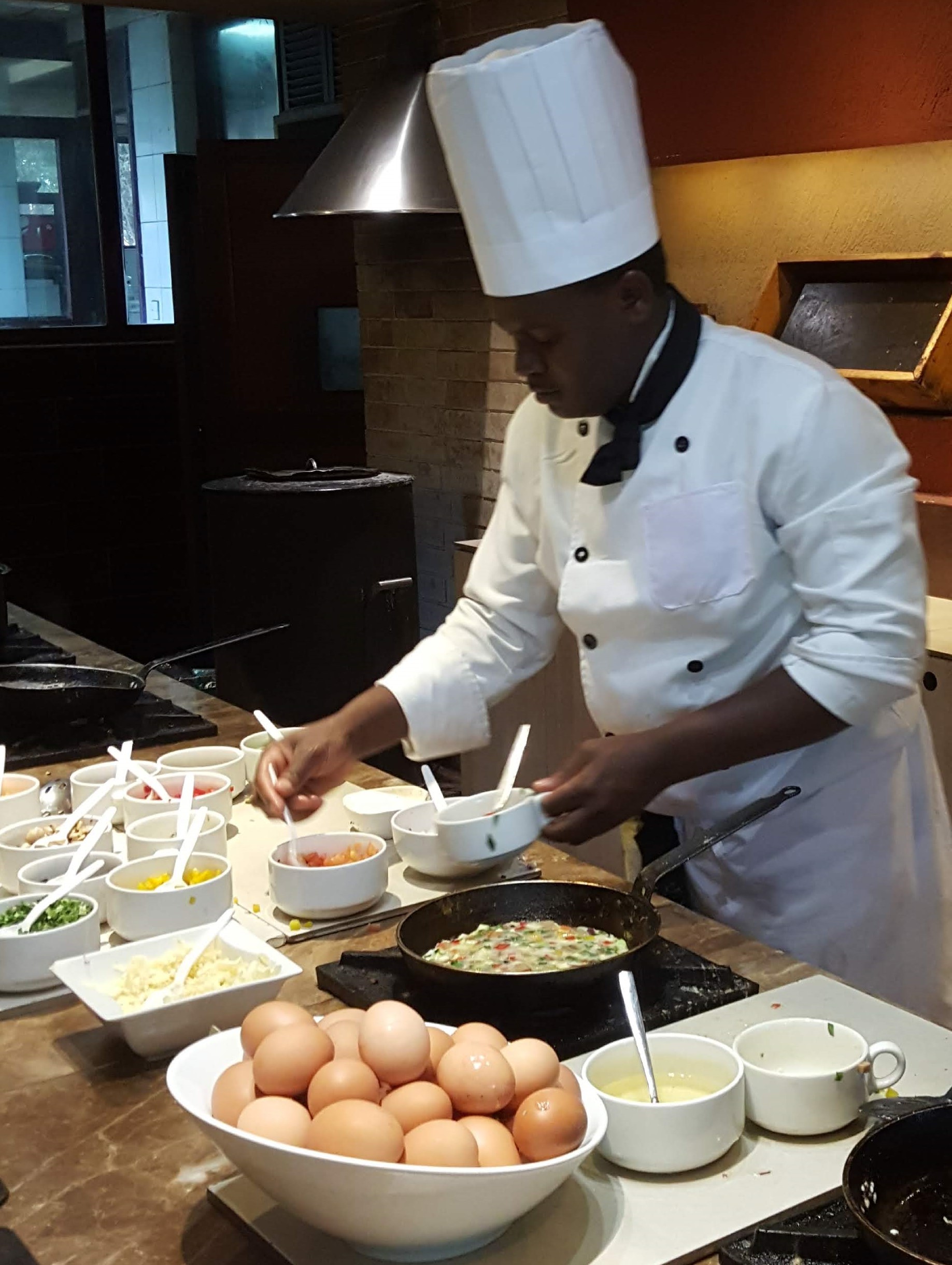
Omelette chef
At breakfast, Nancy ordered an omelette from the “Egg Station” and toasted a thick slice of brioche to go with it. Michael couldn’t pass up the French toast, fresh off the griddle, that was offered for the first time today. (Nancy had already requested the omelette before noticing the French toast, so she hopes the latter will be offered again tomorrow.) We both enjoyed steaming cups of hot chocolate made with Cadbury cocoa.
Another game drive was scheduled at 9:30, right after breakfast. Once again we teamed with Eva and Barry, but this time the four of us got into a vehicle driven by Amos.

One of our regular river crossings
Since coming to the Maasai Mara region, we have discovered that dramatic river crossings are not something that only the animals do. Every time we leave the Ashnil Camp, our Land Cruisers have to navigate across a narrow branch of the Talek. The rain we had last night made today’s crossings a little trickier than they had been yesterday. The water level had not risen much, but the road was muddy and the rocks slick. We continue to be grateful for our incredibly skilled drivers.
We stopped for a while to observe a pride of lions–three females, and a young male whose mane had only begun to develop–finishing a meal. We didn’t stay long. Not that they needed to tap dance or anything to maintain our interest; it’s just that we had something else on our agenda for the morning: we hoped to see a lot of wildebeests cross the river.

A prime place for a crossing of the Mara
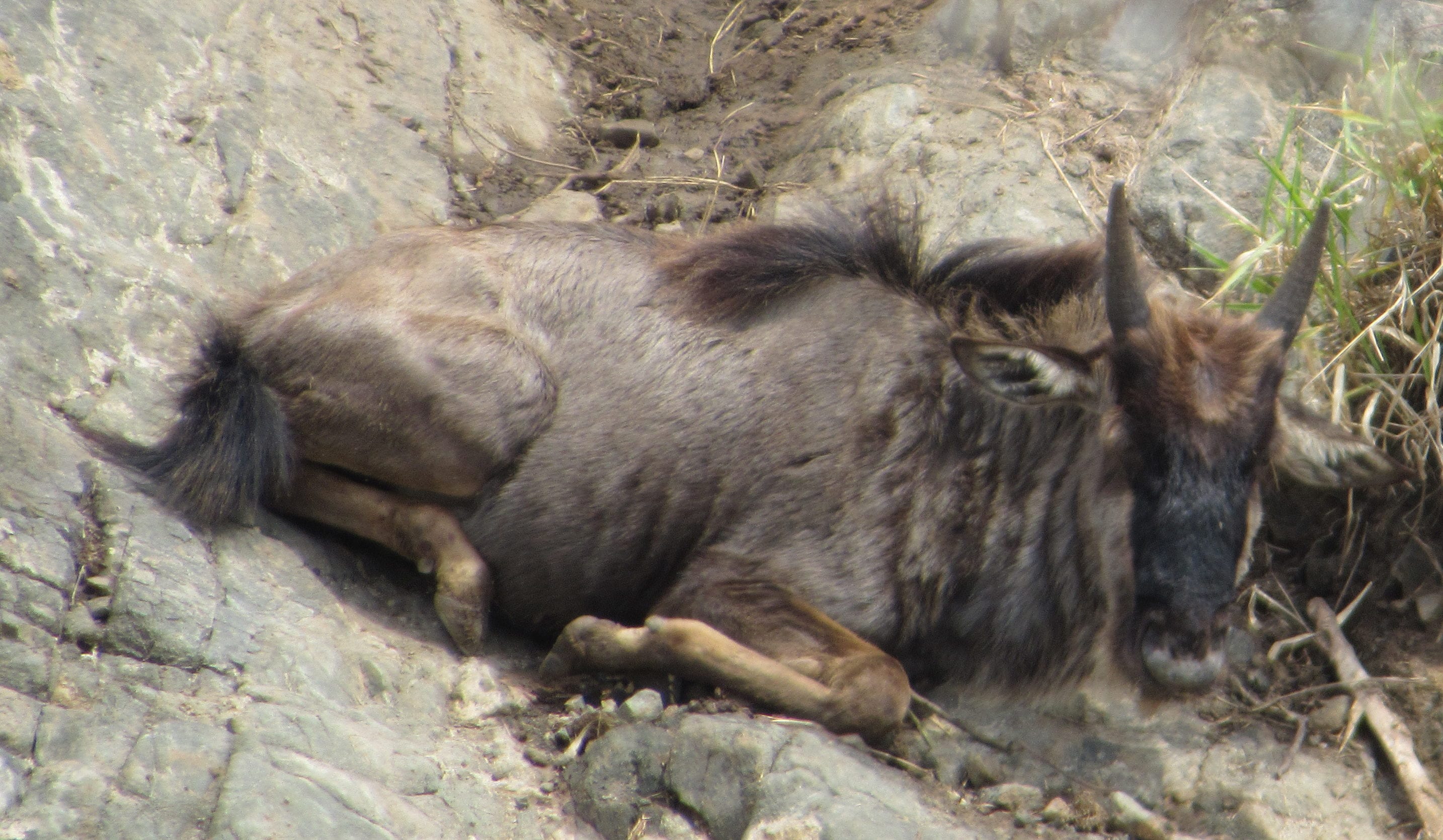
Injured baby wildebeest
Amos took us a little upstream from where we had parked last night. Here the Mara winds through a wide gorge with deep escarpments on each side, and from the ridge above we had a good view of some craggy slopes down which, if we are lucky, hordes of wildebeests might begin to careen. We heard that we had missed a significant crossing this morning after we went back to the camp for breakfast; tracks in the dirt showed us where it had taken place. On the rocks about halfway down the opposite bank, we spied a baby wildebeest that must have collapsed in the melee. It was still alive but apparently incapable of getting up, and now had been abandoned. At some point, a trampled carcass floated past us.
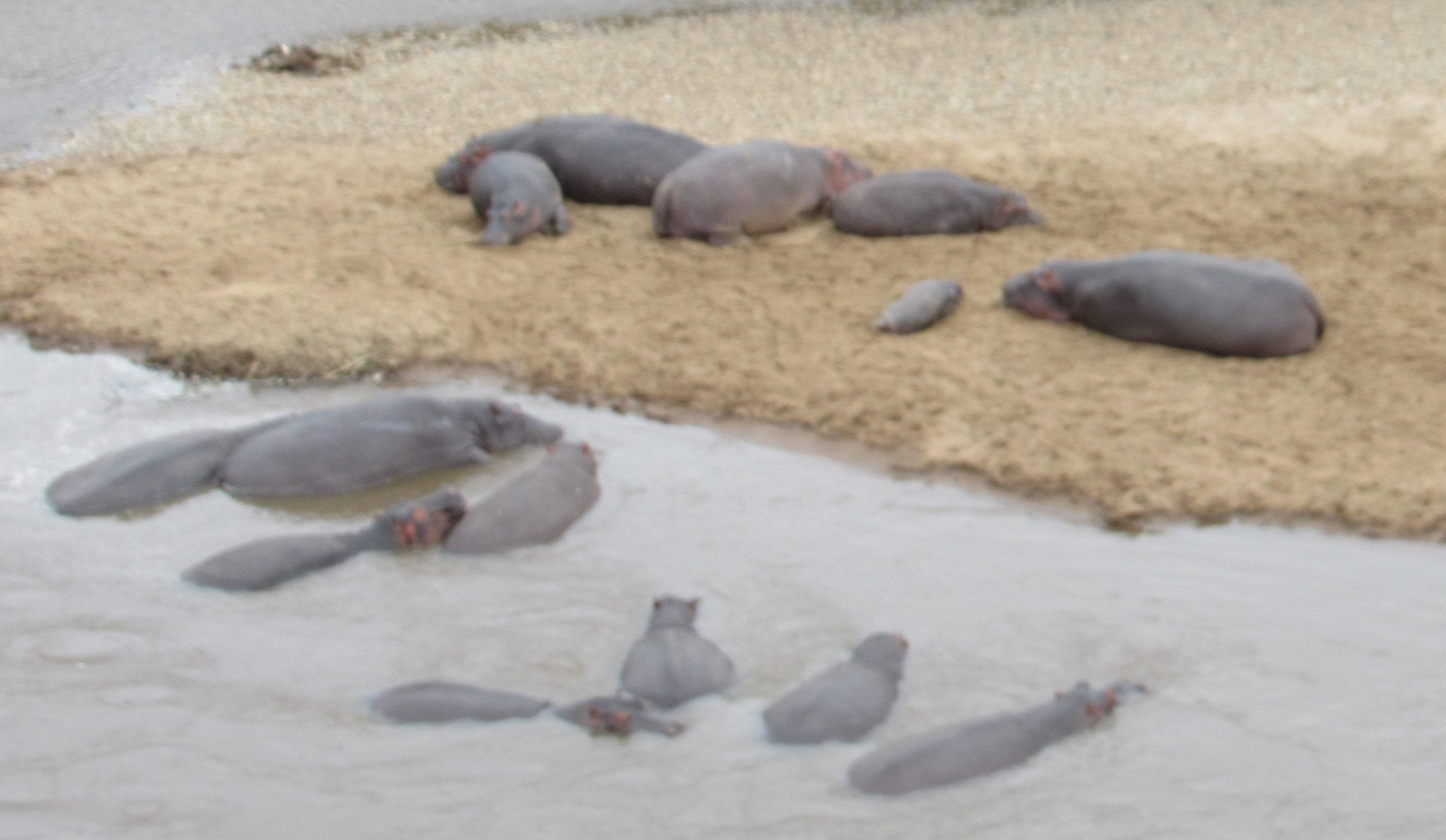
School of hippos
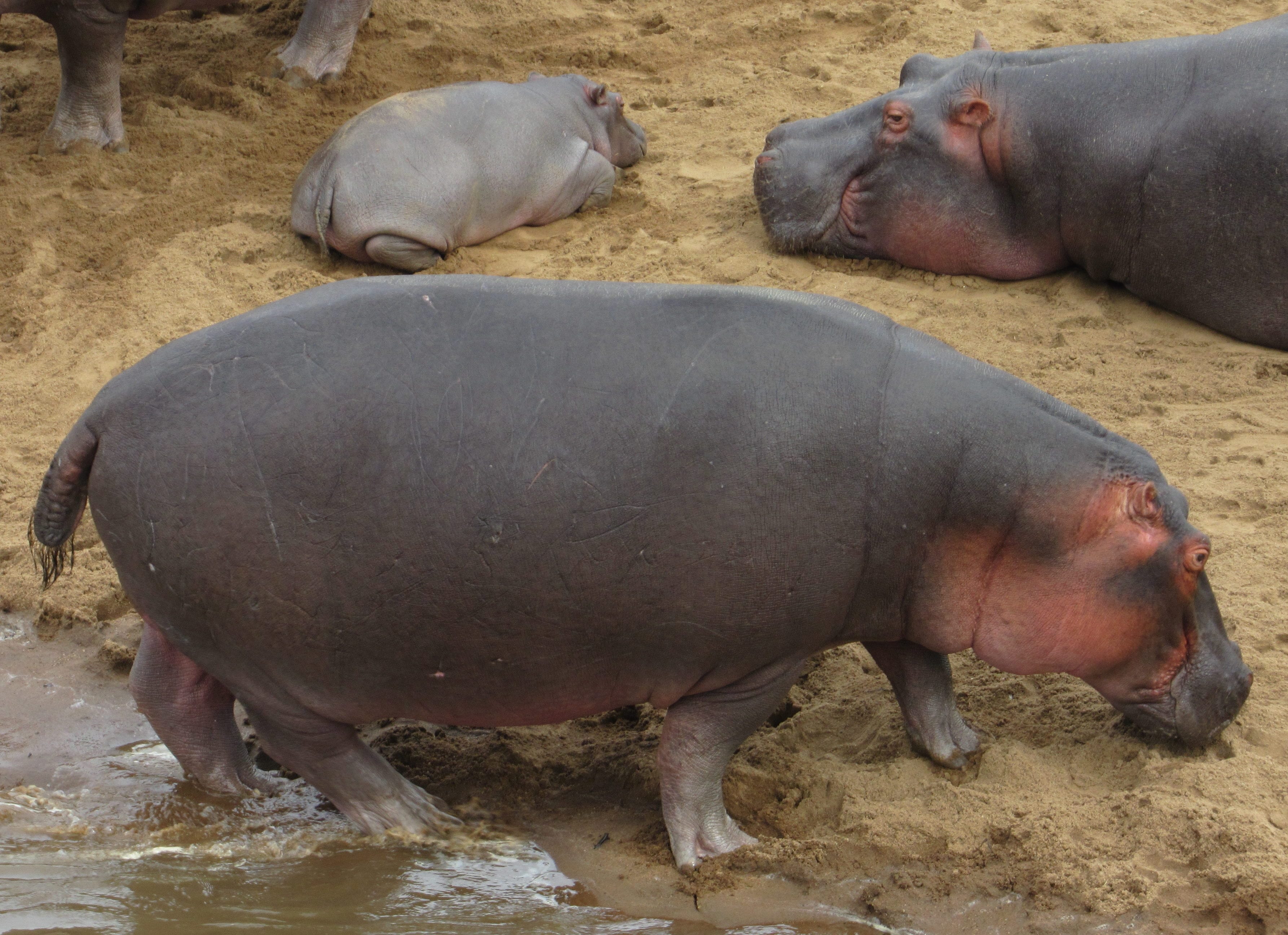
Juvenile and baby hippos
As we waited for distant herds to move closer, we enjoyed observing a school of beached hippos that included a baby and some other juveniles.
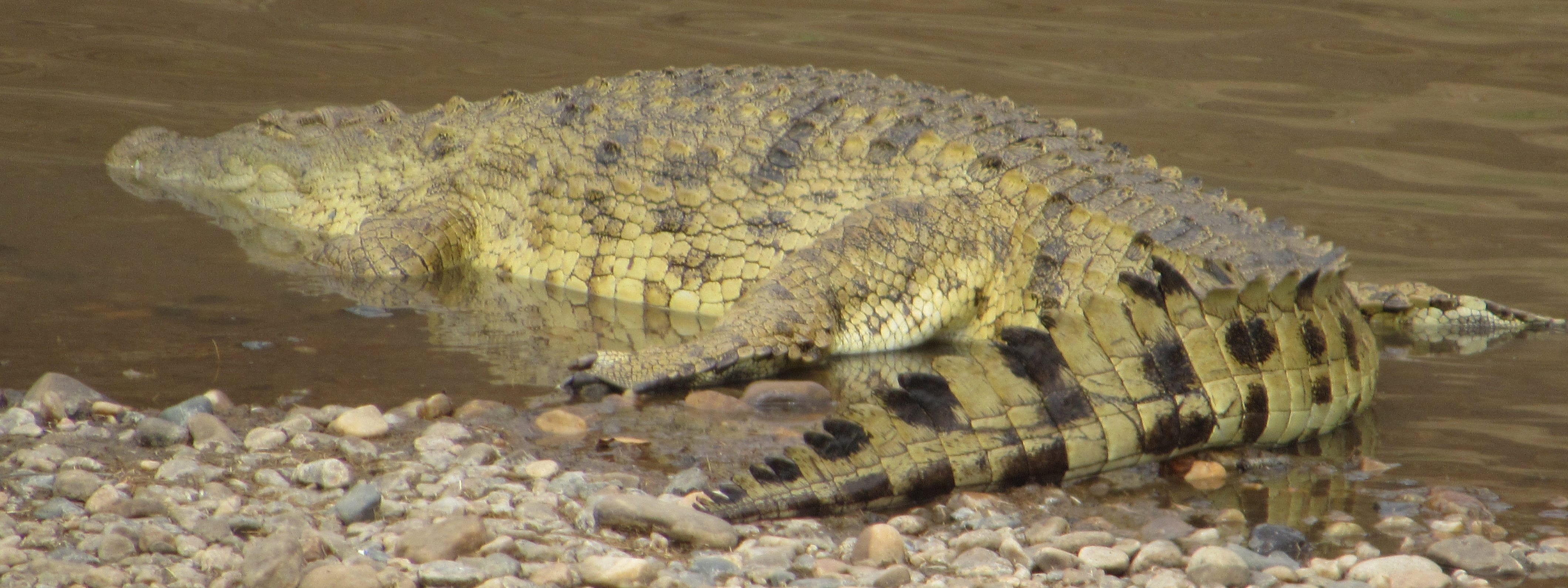
Crocodile
A couple of large crocodiles were lurking on islets farther downstream. (We were glad that we were safely out of reach.) Closer at hand–just outside our vehicle, in fact–we could watch a lot of colorful birds hunt for insects among the bushes at the top of the ridge. A darling little bee-eater, no more than six inches long, kept returning to its perch on the same twig after darting for flies, and a red-necked spurfowl was busily poking its head into an anthill.
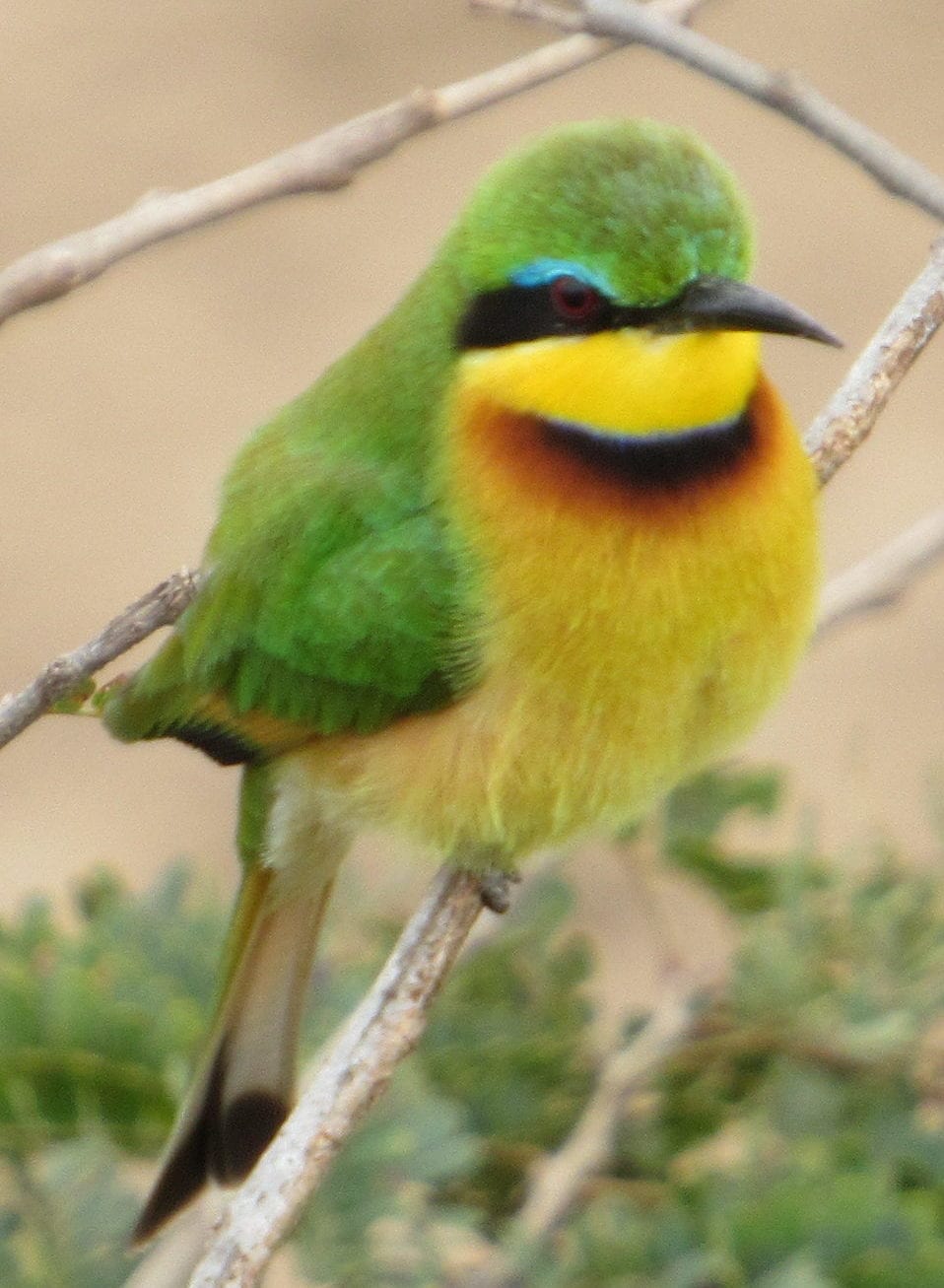
Little bee-eater
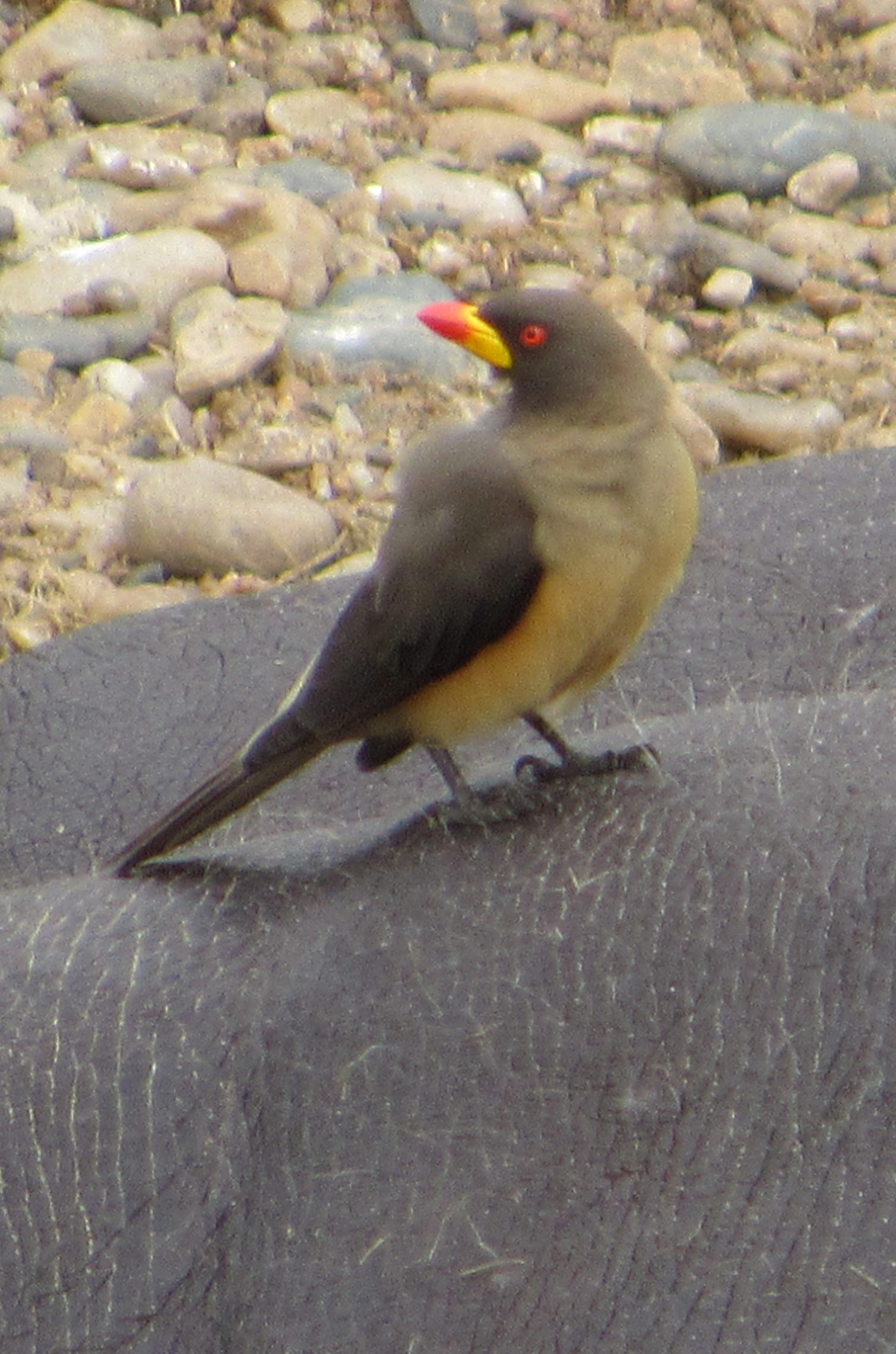
Red-billed oxpecker on a hippo
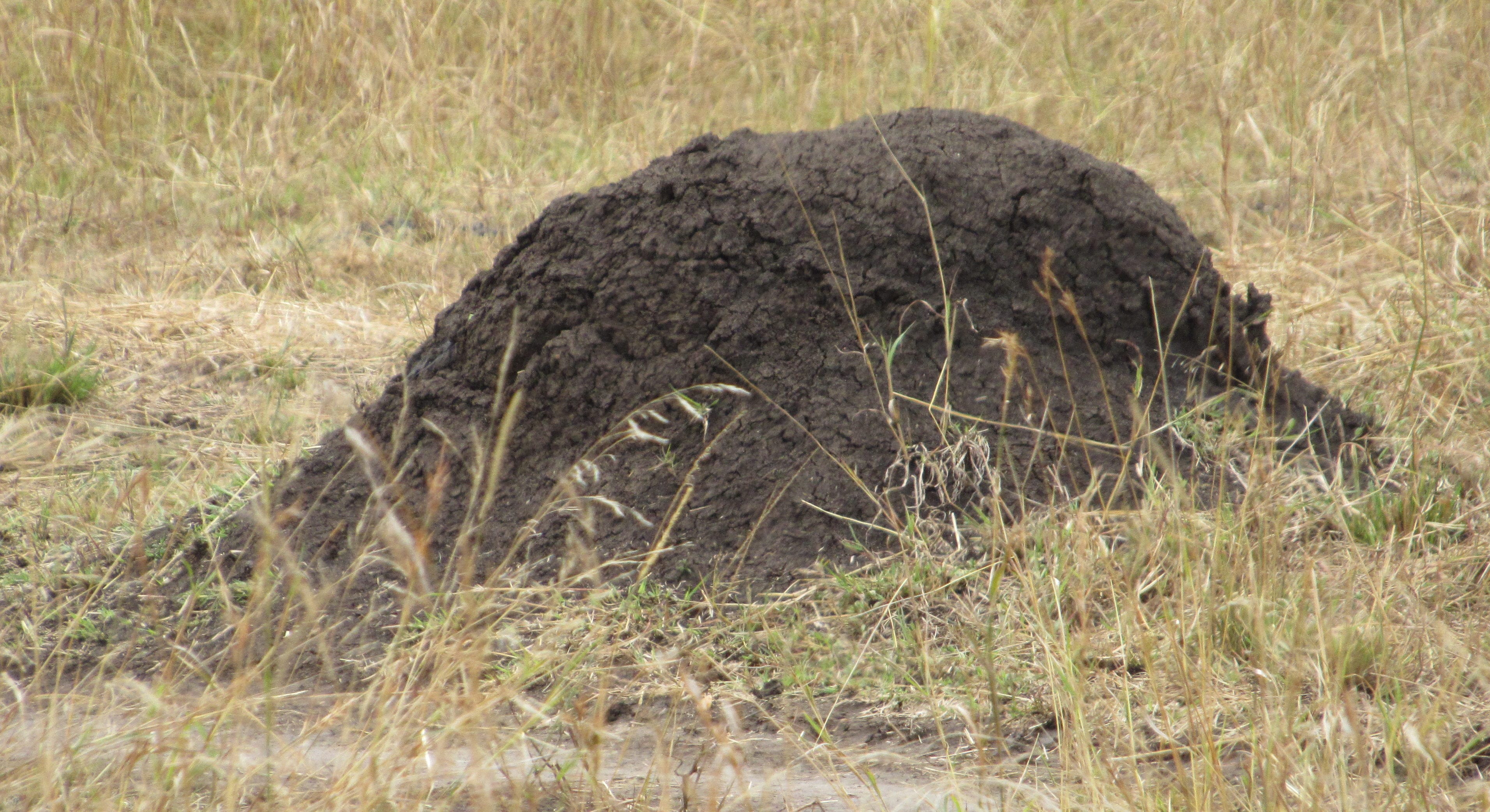
Termite mounds in the Mara region are darker than those in Samburu. There isn’t much wood in the savanna, so the termites here eat grass, roots, and bits of plant matter in the soil
For about an hour, we had been watching a train of wildebeests on the other side of the river coming and going, coming and going, but never building enough momentum to make a crossing seem imminent. What we hoped to see was a significant number of animals–scores, if not hundreds–gathering at the edge of the escarpment. From there (we are told) it would take only one to decide to go down to the water, and then all the rest would follow. What makes the sight so dramatic is that once the crossing has begun, the herd mentality takes over and the animals just start leaping after those in front of them, whether or not there is a safe path of descent.
Suddenly, Amos started the engine and told us to hang on. The CB network had sent word that a crossing had begun at another bend in the river about a mile away, and soon we saw dozens of vehicles racing from all directions toward the same spot. As we came closer, we could see a train of wildebeests beginning to assemble near the river. However, the sudden rush of vehicles–we counted at least sixty-five–distracted the animals and slowed their momentum. Worse, a few of the vehicles actually drove through the herd itself, causing the train to become disconnected and the animals in the rear to stop moving.
“They shouldn’t have done that,” Amos said. “Drivers should never interfere with the herd.” We could tell he was angry–as was Jim when we discussed the matter with him later.
“Disconnecting the herd like that is totally against the rules,” he explained. “Those drivers could get fined–and I hope they do!”
Before long, even the animals that had been at the head of the train turned away from the river and wandered off in another direction. Oh well. We could only hope they would try again later.

Mongoose burrow
On our way back toward the camp, we came upon a pack of mongooses–Africa’s equivalent of prairie dogs. The creatures scurried out of sight too quickly for us to get photos of anything but their burrow.
We also stopped to watch a lion couple lounging in the grass. From the length of his mane, Amos estimated that the male was only three or four years old.
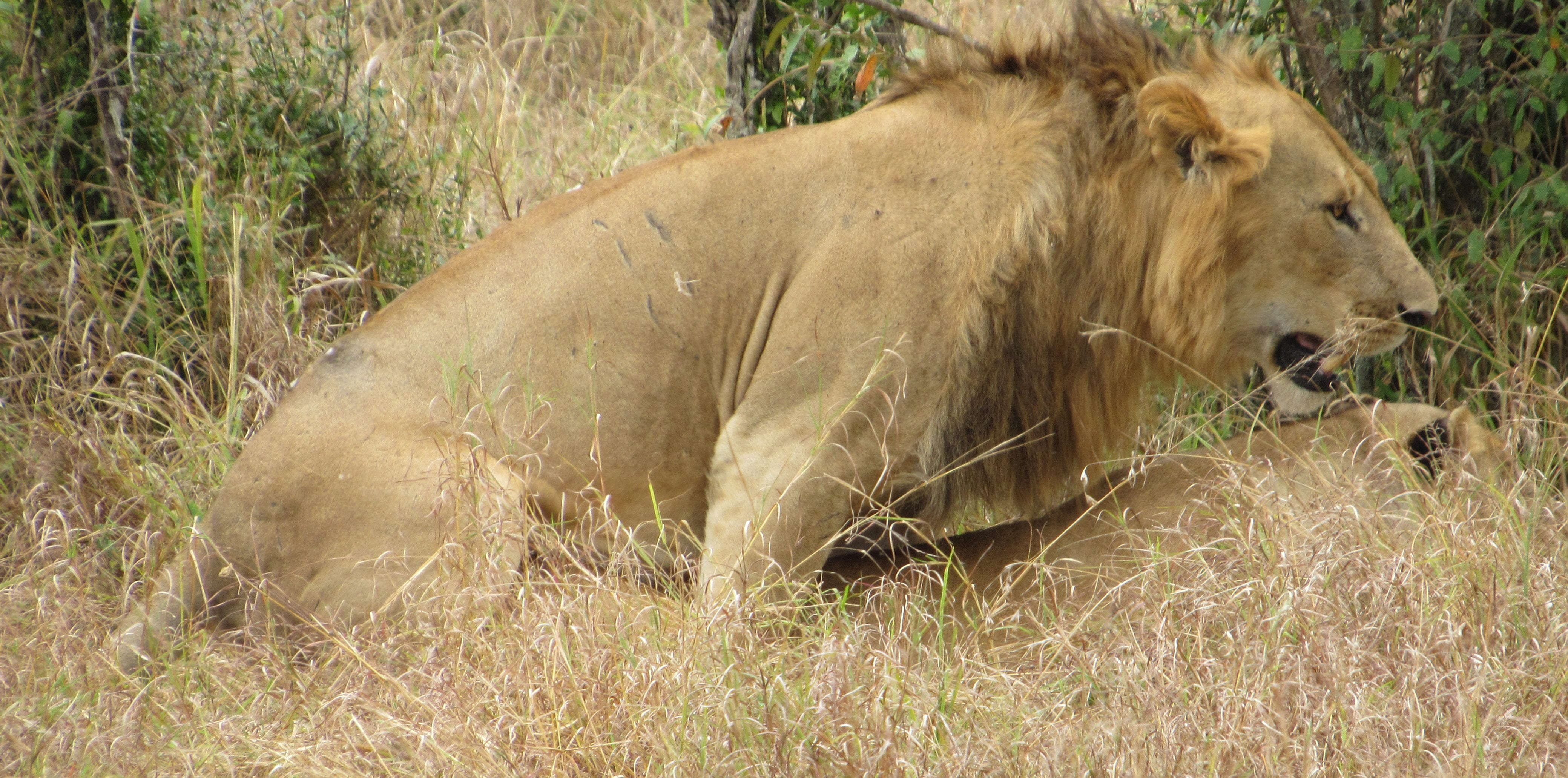
Mating lions
As we watched, he got up and mounted the female–thus settling the question of whether the two were mates or siblings.
“It’s likely that he only recently won the right to mate,” Amos told us.
When the coupling ended a minute later, the male roared, and the female turned around and swatted him in the face. A second attempt at copulation about five minutes later ended almost as soon as it began.
“Definitely young and inexperienced,” Amos decided.
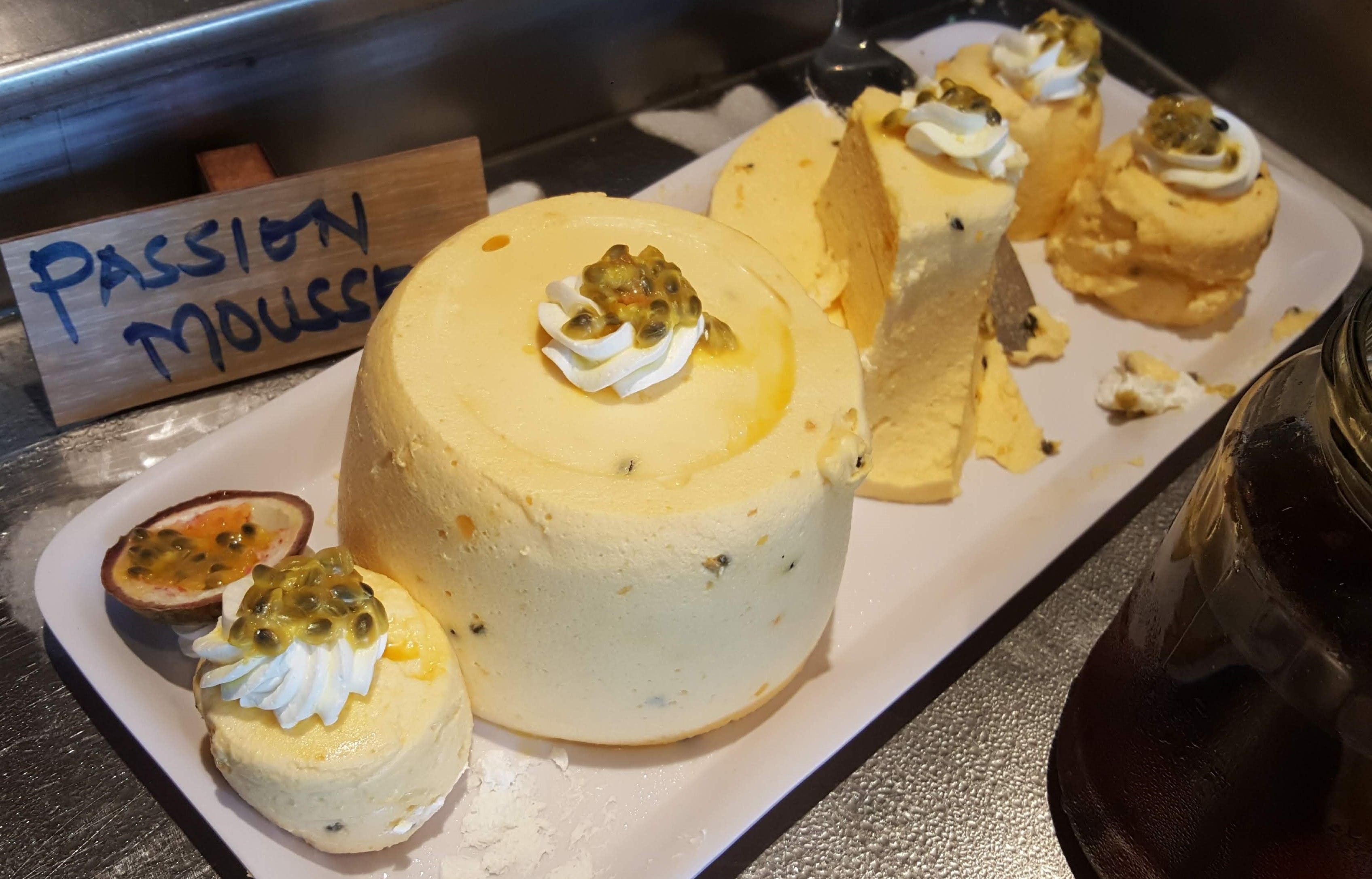
Yummy passion fruit mousse
The lunch buffet was a little like our morning had been: filled with many delights and one big disappointment: the passion fruit mousse looked amazing, but contained too much gelatin and too little passion fruit. Afterward, while Michael took a nap, Nancy did some laundry and then went off to explore the camp. Later, we were able to use the wifi in the lounge without the annoying midges.
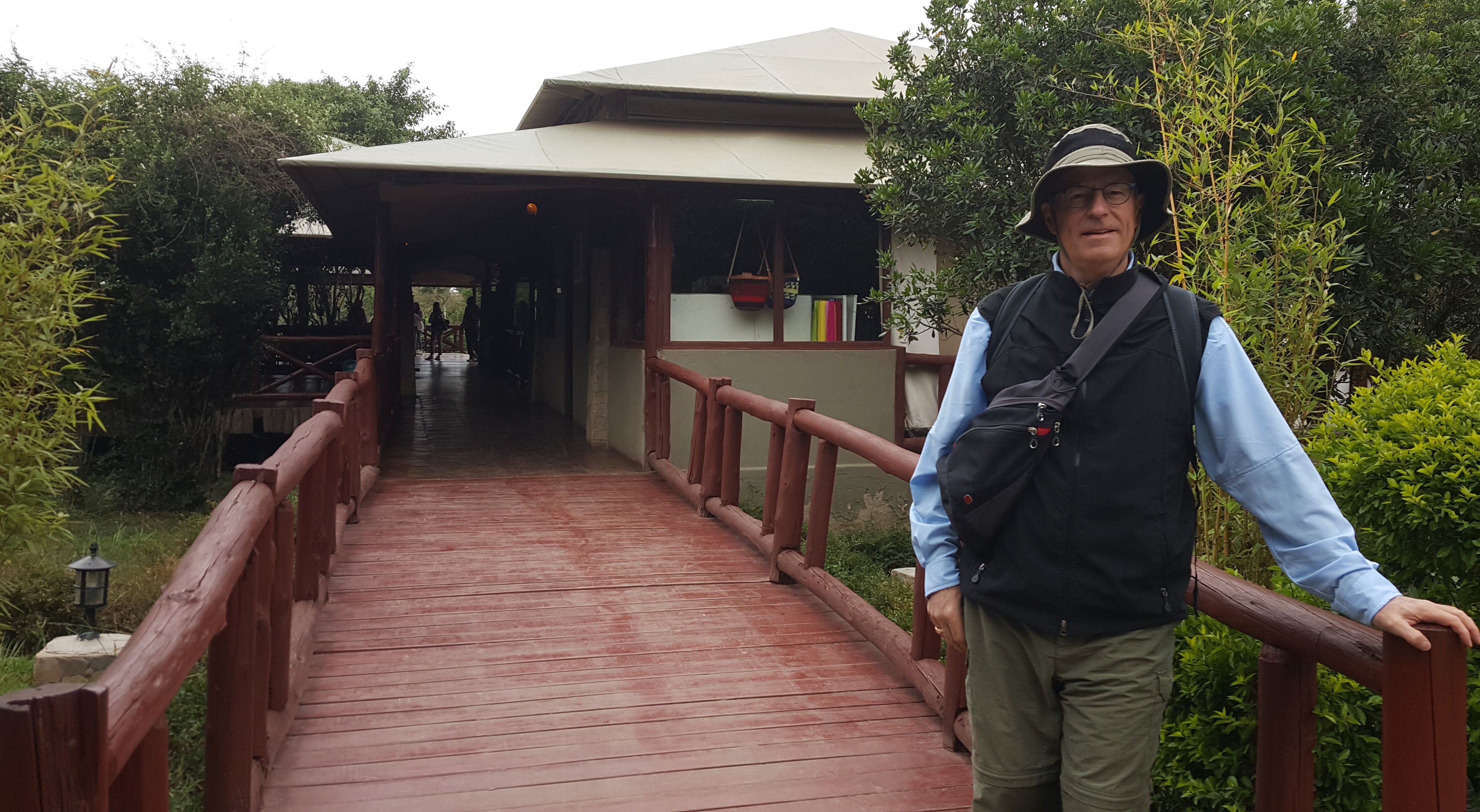
Entrance to the dining area
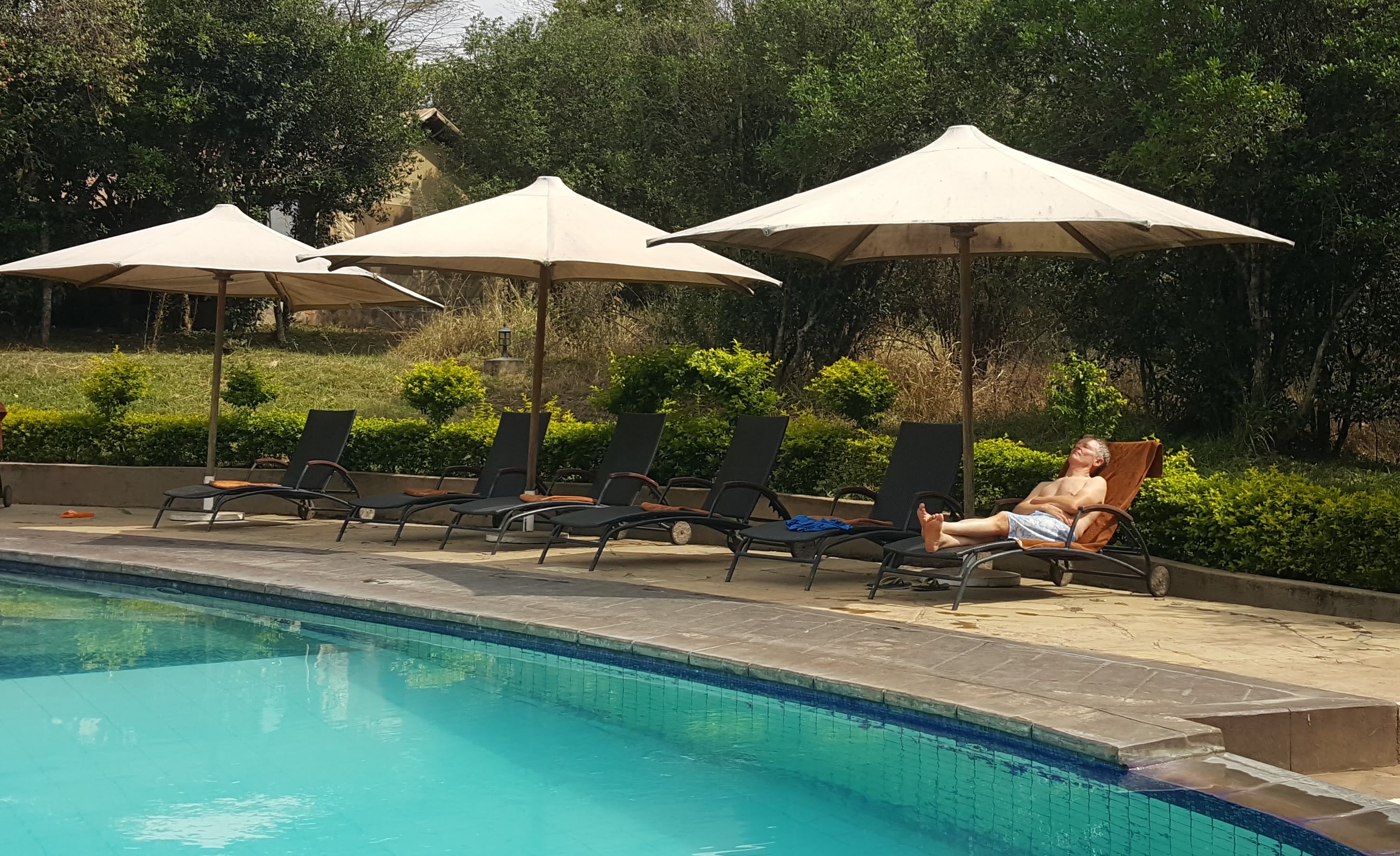
Bryce catches some rays near the pool
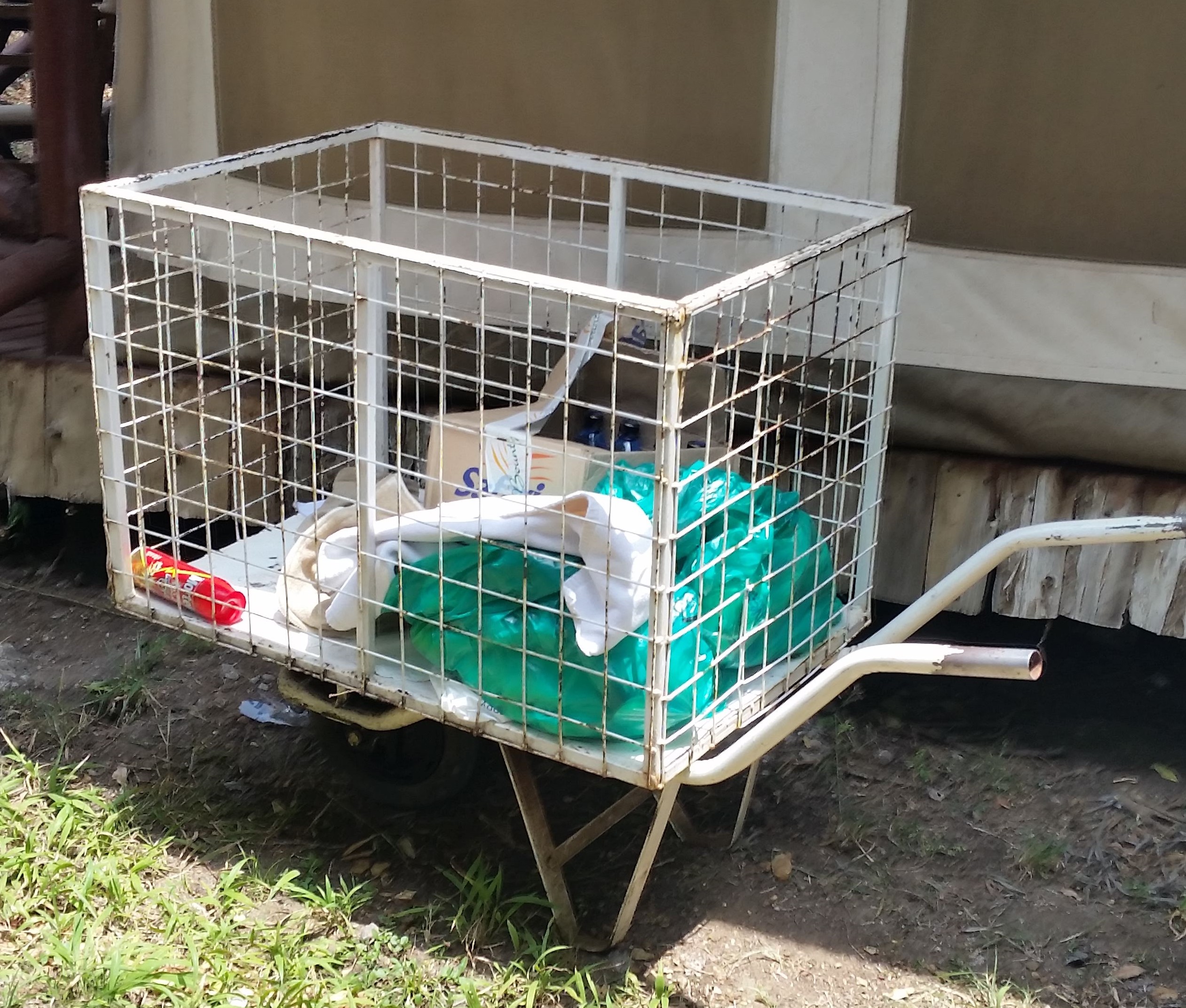
A housekeeping cart begins to fill with guests’ garbage and dirty linens
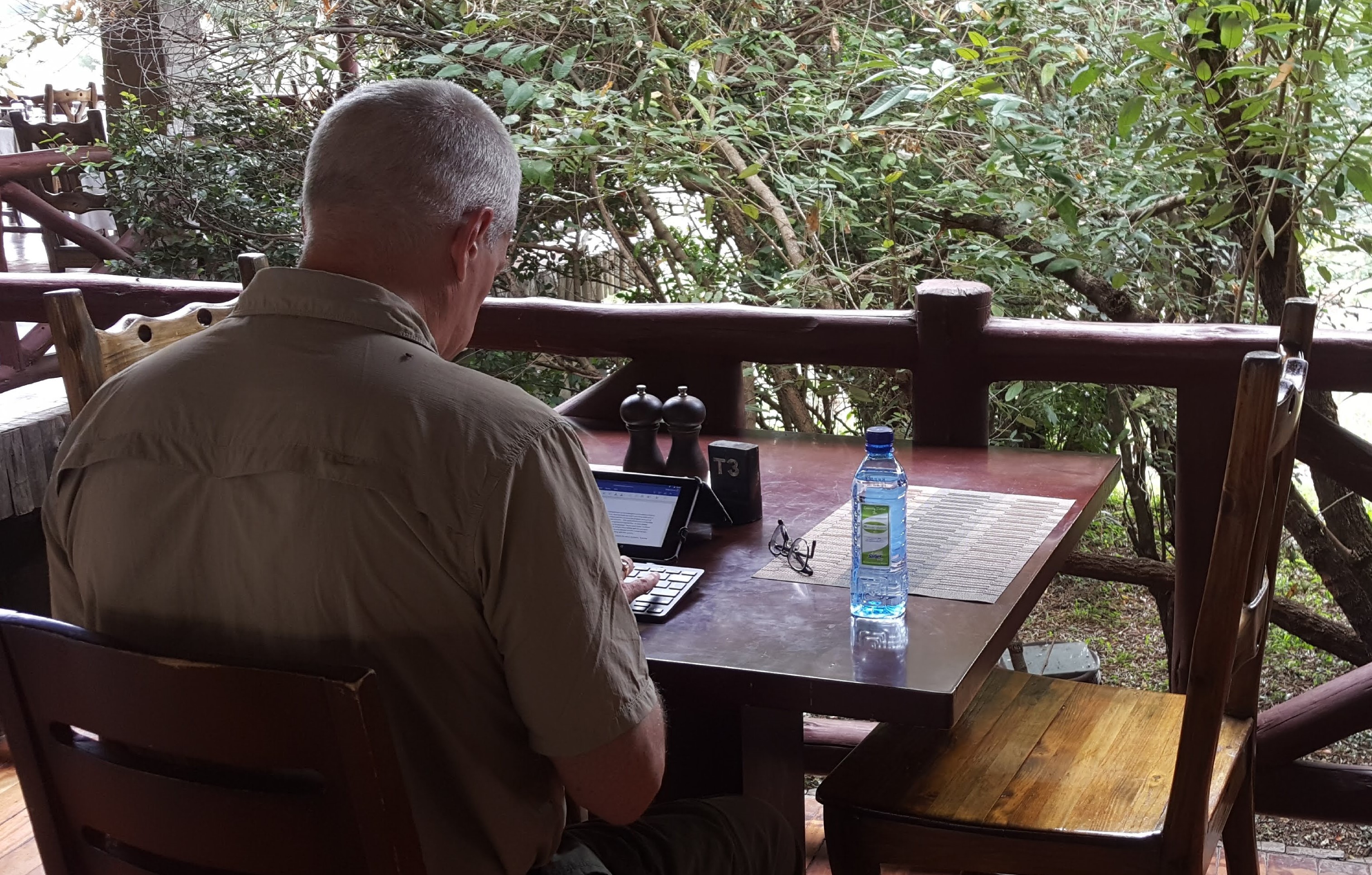
Better than a corner office
A few clouds had begun to appear on the horizon when the time came for our evening game drive, so Nancy stuffed a raincoat into her backpack along with binoculars and the notebook she carries everywhere. We followed Pam and Eric into Geoffrey’s Land Cruiser.
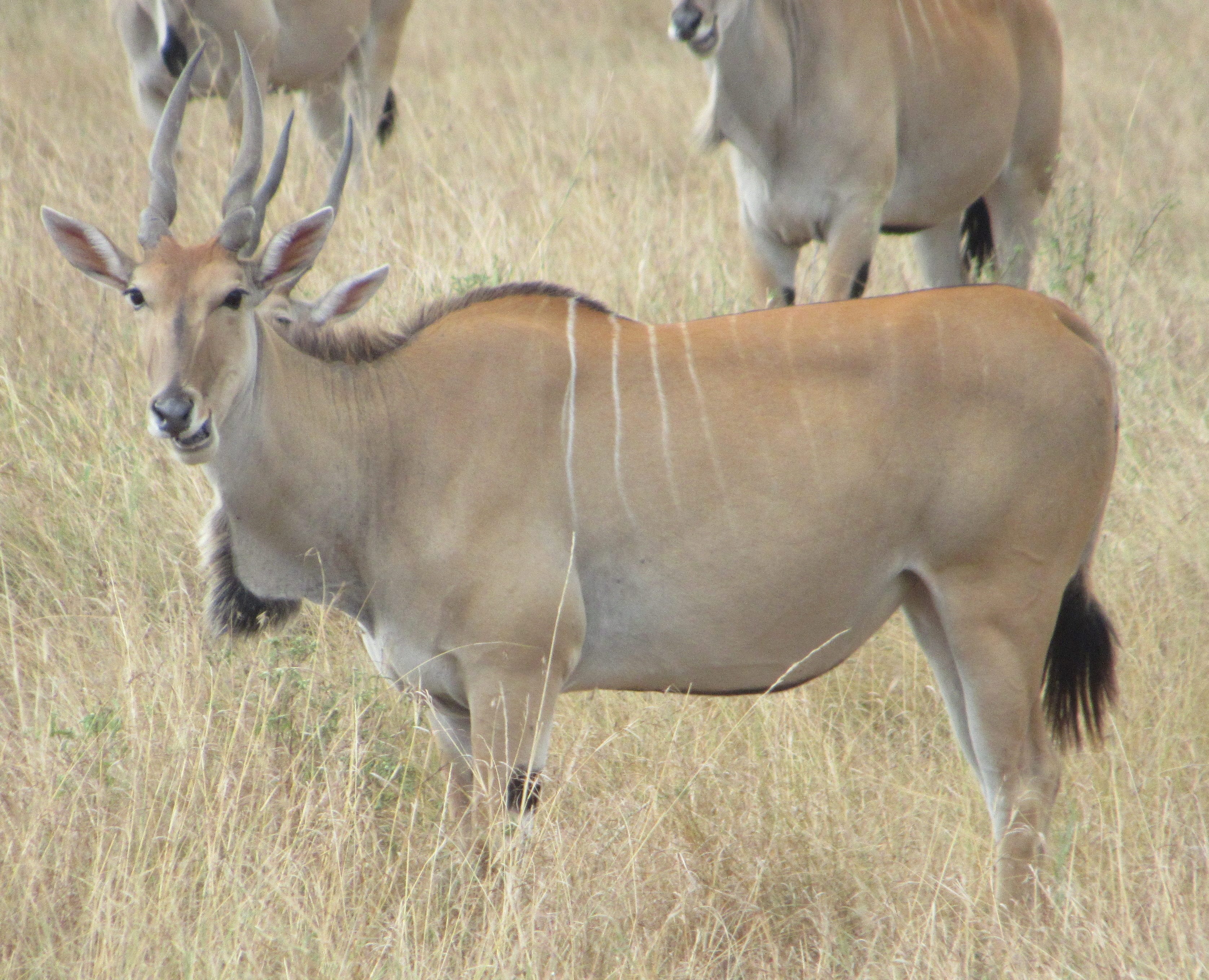
Eland
“I haven’t been able to get a photo of an eland,” Michael told the driver, “so please stop if you see one.” Within minutes, Geoffrey pulled over and Michael got a nice shot of the largest member of the antelope family.

A herd of wildebeests and zebras gather near the Talek River
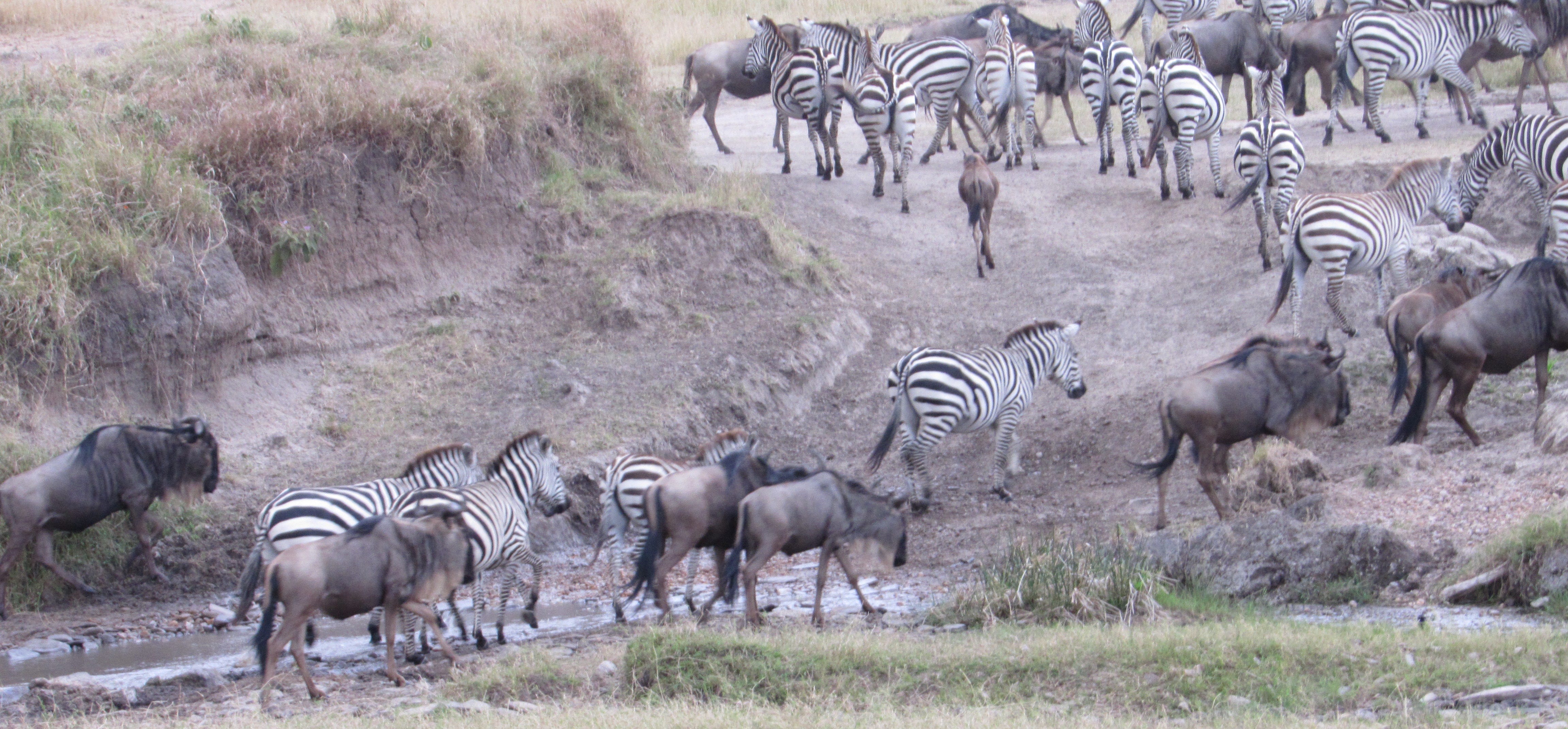
A less-than-dramatic crossing
Disappointed that our quest to view a river crossing had been foiled this morning, but still hopeful that we’d have another chance, we followed a mixed herd of wildebeests and zebras toward the Talek River. Unfortunately for us, the place where they chose to cross offered no steep drops and therefore no drama.
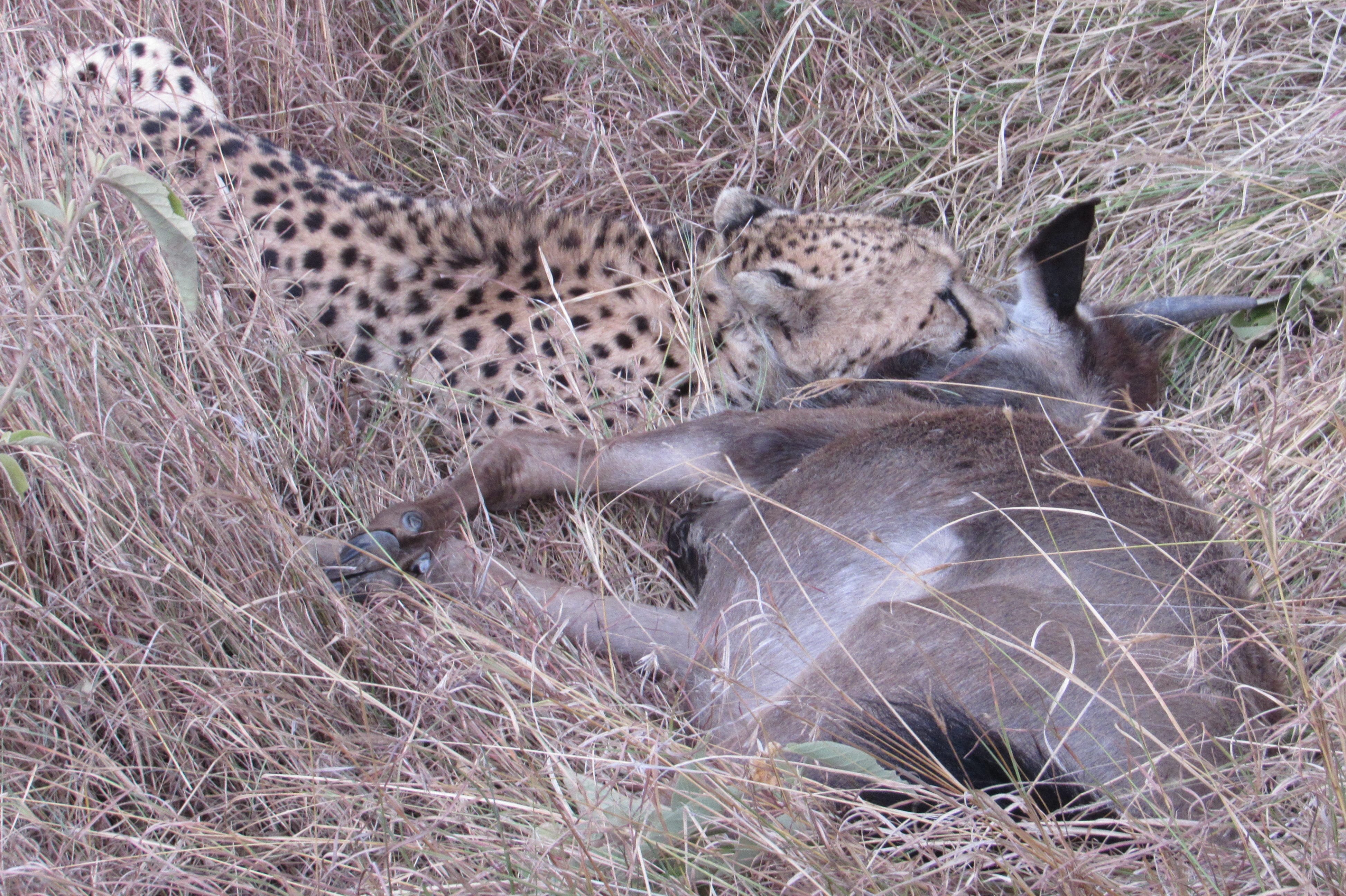
Cheetah holds on to a young wildebeest until it eventually dies
But we didn’t have to wait long for some excitement. As we drove away from the river, a group of wildebeests and zebras up ahead suddenly scattered wildly in all directions. In the midst of the mayhem, we spotted a cheetah that, in a flash, had taken down a young wildebeest. Once the other grazers had run off, we could see that the cat had drug the not-yet-dead animal to a depression where it was somewhat hidden by tall grass. Geoffrey pulled up close as the cheetah, its jaws firmly grasping the wildebeest’s neck, waited until the animal died and then proceeded to tear into the hindquarters. By this time, a few other vehicles had joined us, creating a circle around the cat and its meal.
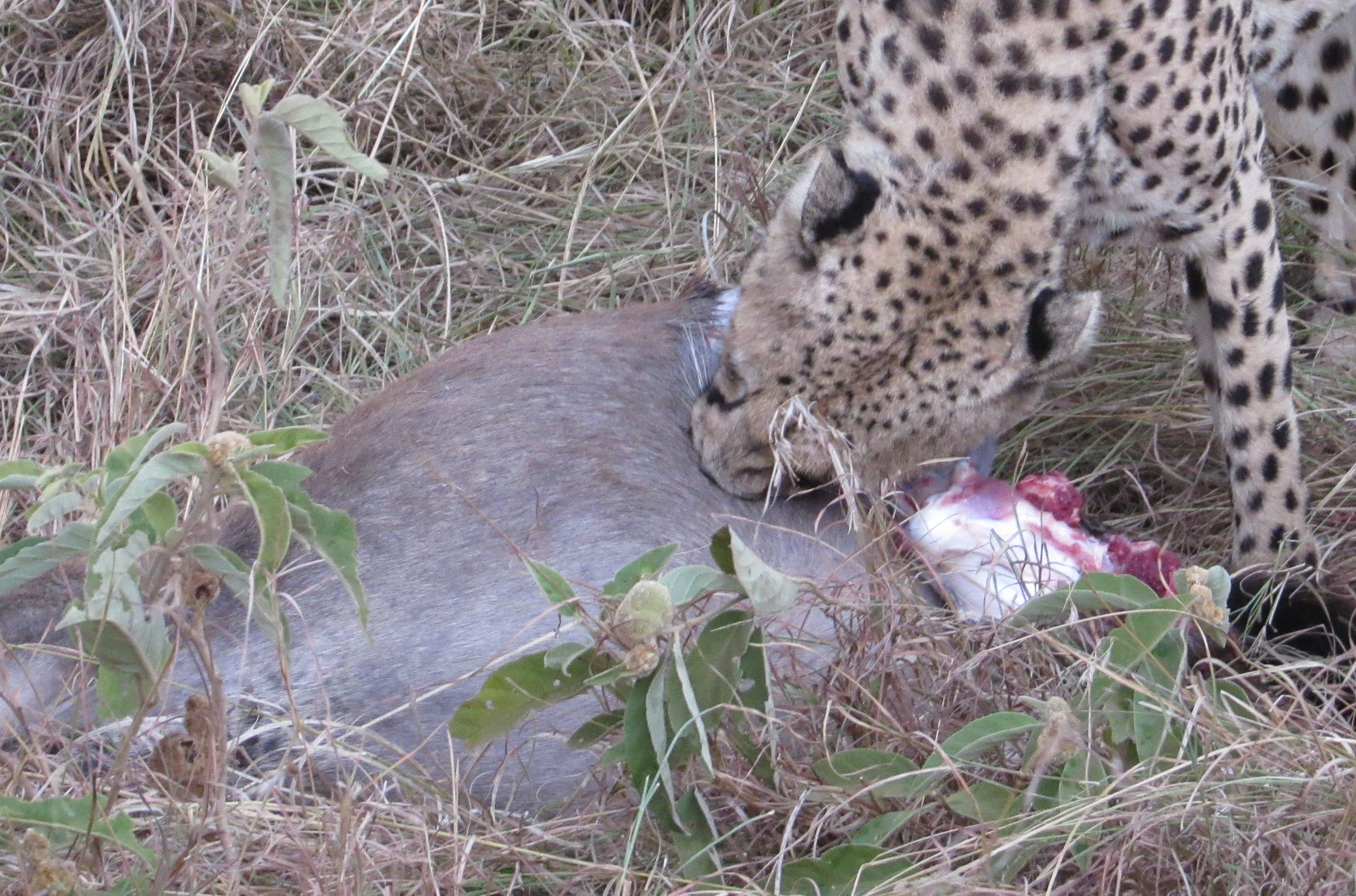
The cheetah prefers the hindquarters and is careful to not burst the entrail sac
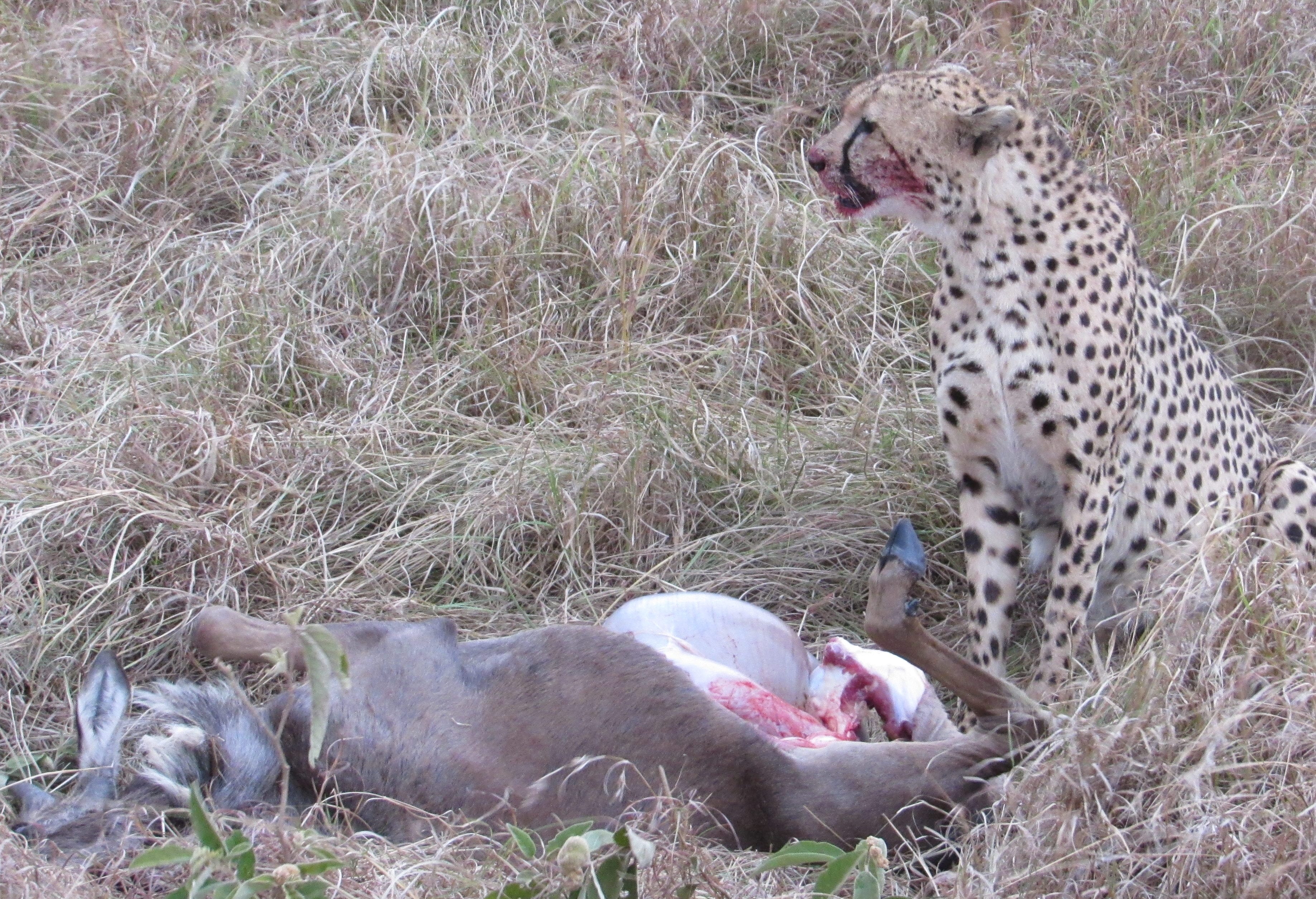
Checking for the arrival of any competitors
“See how he avoids biting into the stomach and entrails?” Geoffrey asked. “He doesn’t want to do that, because the organs have a strong odor that would attract competitors before he has a chance to finish eating. The cheetah’s claws are made for running, not for fighting, so he always has to eat quickly, before another predator tries to take away his meal.”
“Our vehicles are actually doing this one a favor,” Geoffrey went on. “We’re providing cover to protect him from lions and scavengers.”
Later, Jim told us about a cheetah he had seen using two vehicles to its own advantage. The cat crouched between them while surveilling its prey, waiting for just the right moment to pounce.
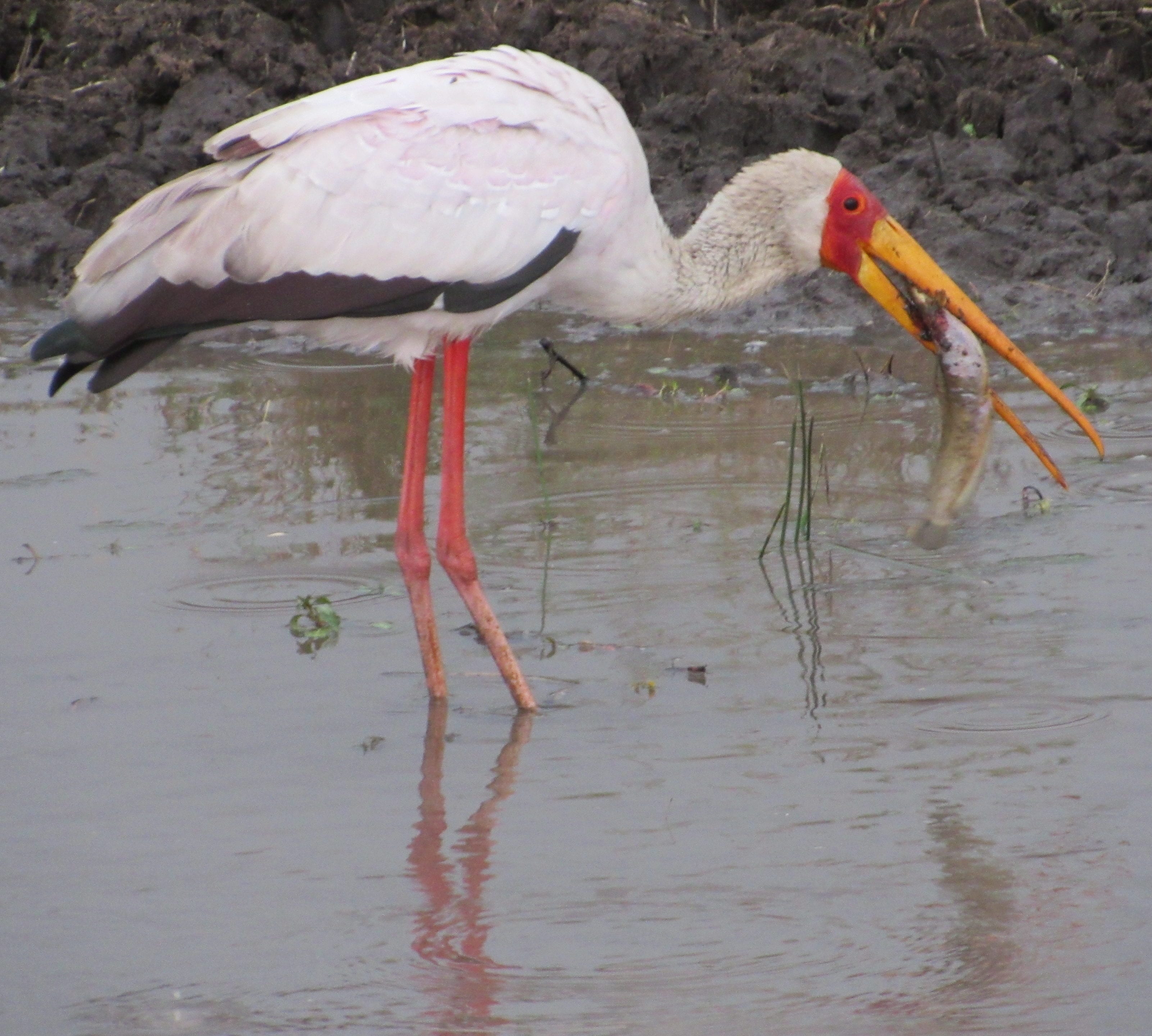
This yellow-billed stork successfully caught a fish
Light rain began to fall as we watched the cheetah continue to tear bites from the downed wildebeest, so we put on our raincoats and began driving again. Near a stream, we saw several yellow-billed storks, fishing. Geoffrey explained their method: the birds open their bills like scissors, stick them into the mud at the bottom of the shallow water, and then clamp them shut when they feel the vibrations of a fish swimming through. If the stork successfully makes the catch, it will bring the fish up out of the water and wait for it to suffocate, then swallow the fish whole.
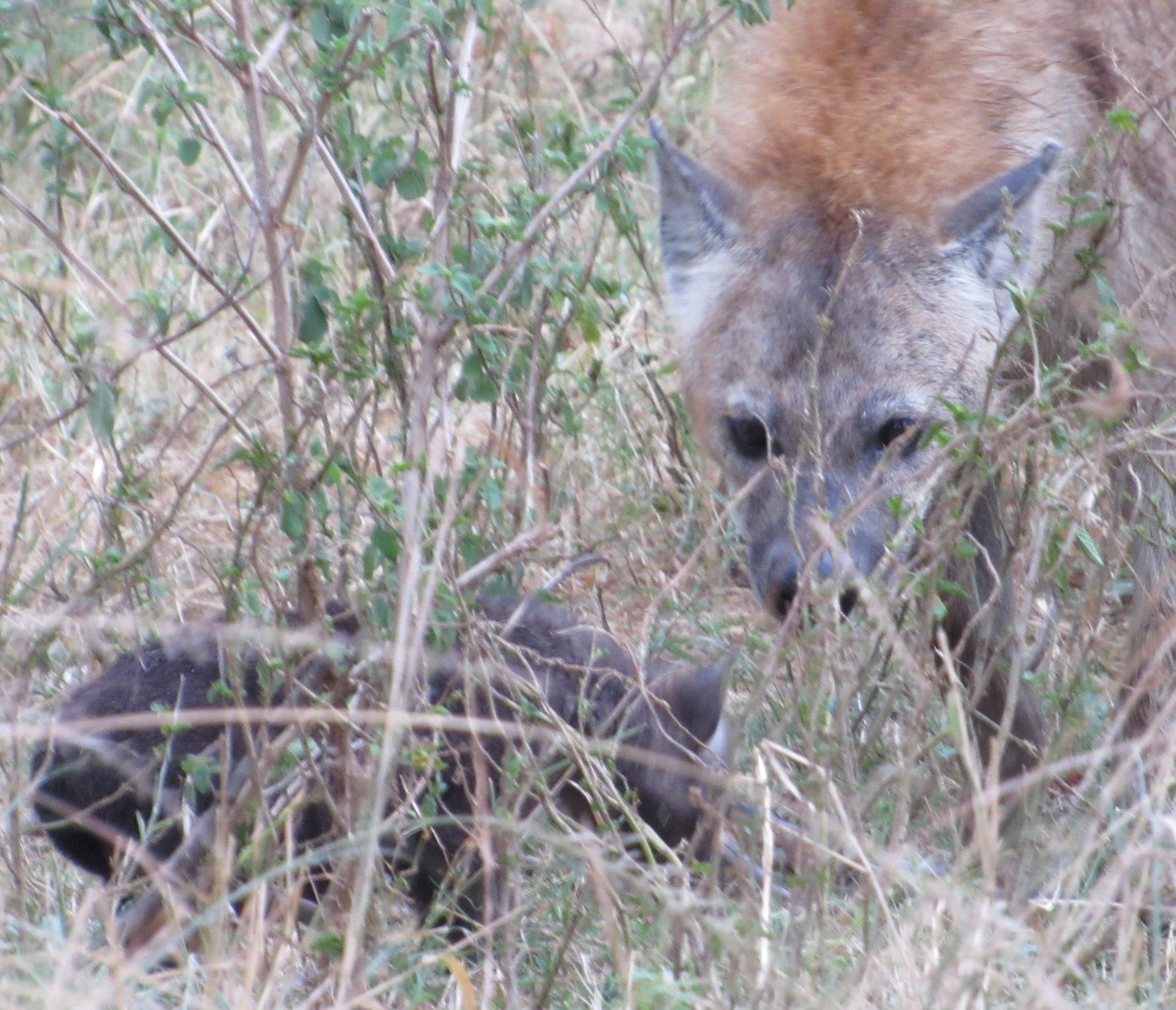
Hyena cubs have dark fur when they are born. As they grow, the fur lightens and develops characteristic spots
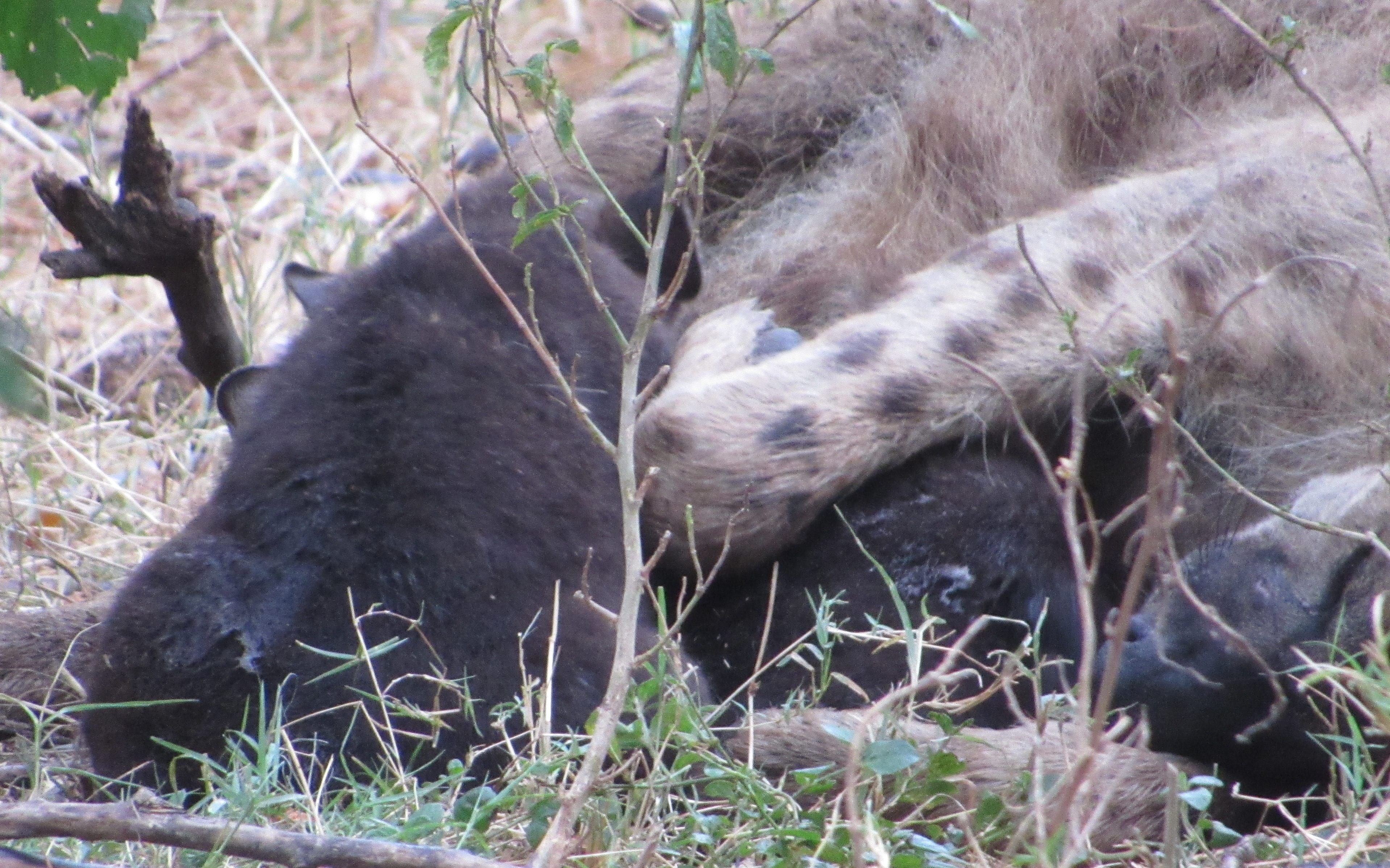
Suckling cub

Hyena den
Moving on, we happened upon a den of spotted hyenas, complete with young cubs. As we paused to watch one mother nuzzle a baby while another nursed her own infant, we considered the disconnect between the tender family interactions we were witnessing and the distasteful behavior for which hyenas are better known. Although despised as the animal world’s gangbangers, hyenas are highly social and affectionate within their own milieu. Females rule, being larger, stronger, and more aggressive than the males, and they also are more involved in the nurture and training of their young. We were glad that we had a chance to see this more positive aspect of hyena life.
The rain began to come down in heavier squalls, so we pulled the Land Cruiser’s top down and headed back toward the Ashnil Camp. We were getting wet even with the top down because the Cruiser’s rear windows had been removed, so Pam and Eric–who had not brought raincoats–moved up to the front. The unoccupied seats in the very back became coated with a thin layer of mud as moisture mixed with the dust of previous days. The downpour created an additional challenge in that once-dry ravines were becoming rivulets, and the slow streams we had crossed earlier had widened into freshets. At one point, we were thwarted by a “Road Closed” sign that the rangers must have posted only recently. Geoffrey stopped for a moment to consider his options, then turned the Land Cruiser around and headed in a different direction. Good thing he knows his way around this territory, because we had no idea where we were going.
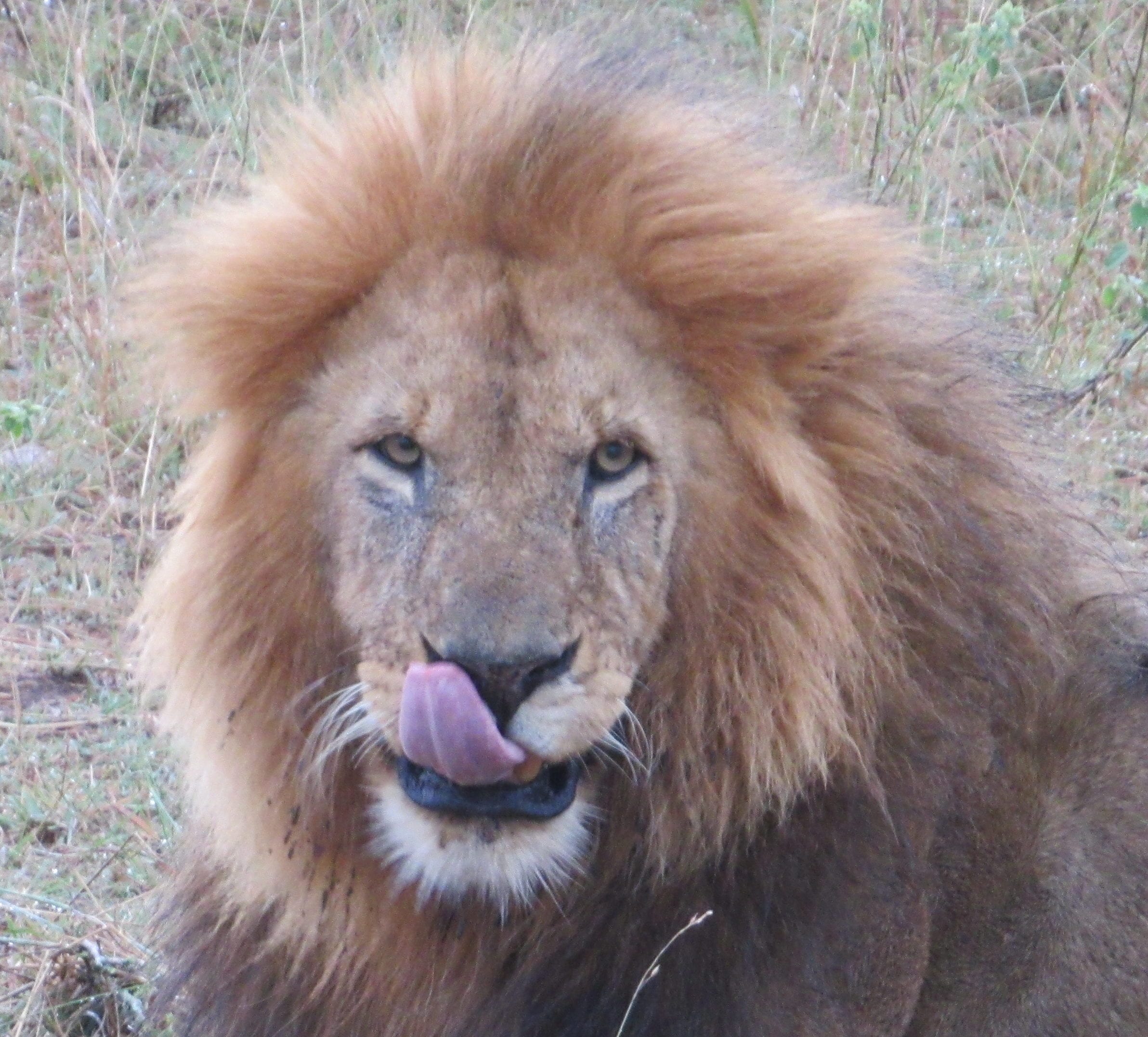
A more experienced lion
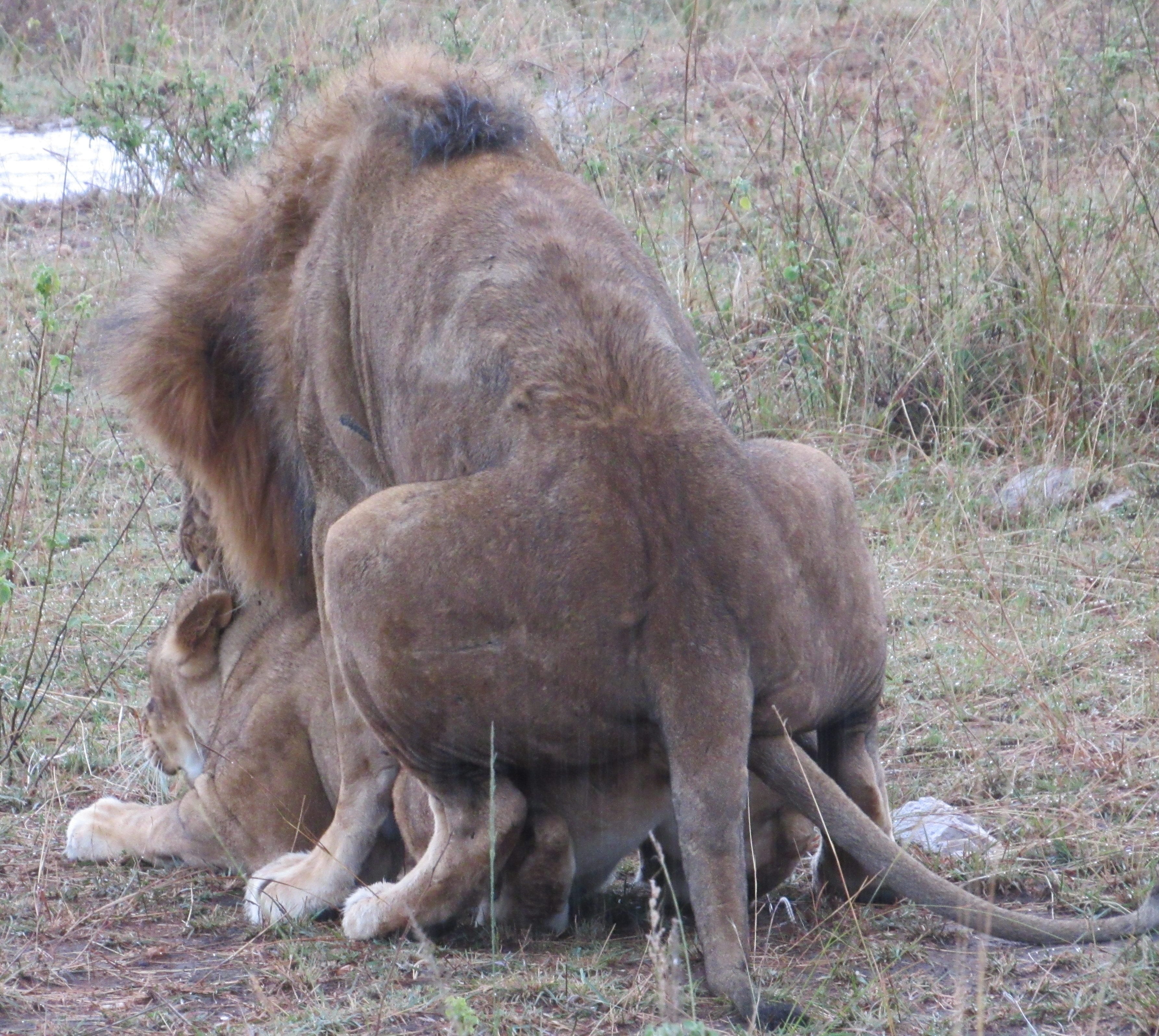
Maybe we should have given this post an R-rating
The alternate route led us to another lion couple, both of whom startled when our vehicle ran over a branch with a loud snap. This was the first time we’d seen any lion act the least bit nonplussed by our presence. The male had a full, majestic mane, and obviously was more experienced in the sexual arts than the neophyte we had seen earlier. A while later we passed two other males who didn’t seem to care that their full manes were getting wet.
By now it was raining steadily, making every surface slick and treacherous. Unexpected detours had put us behind schedule, and low clouds were hastening the onset of darkness, so Geoffrey picked up the pace. More than ever, we felt as if we were bumping through the Indiana Jones Adventure at Disneyland–except that the white-knuckle thrills Geoffrey was providing for us were not for the sake of entertainment. As we approached a swollen stream that we couldn’t avoid crossing, we realized that the Discovery XA Land Cruiser ahead of us–Steven’s–was stuck in the mud. Geoffrey shifted into all-wheel drive and cautiously crept toward the disabled vehicle. By carefully rocking against the other Land Cruiser, he was able to dislodge it and push it up the bank, but the acrid smell of burned rubber that rose from our tires testified that it hadn’t been easy. Steven was embarrassed to have gotten stuck, but we all recognized that even the best of drivers can’t fully control every situation. We were relieved that the operation was successful, and grateful that the Discovery XA team is more interested in cooperating than competing.
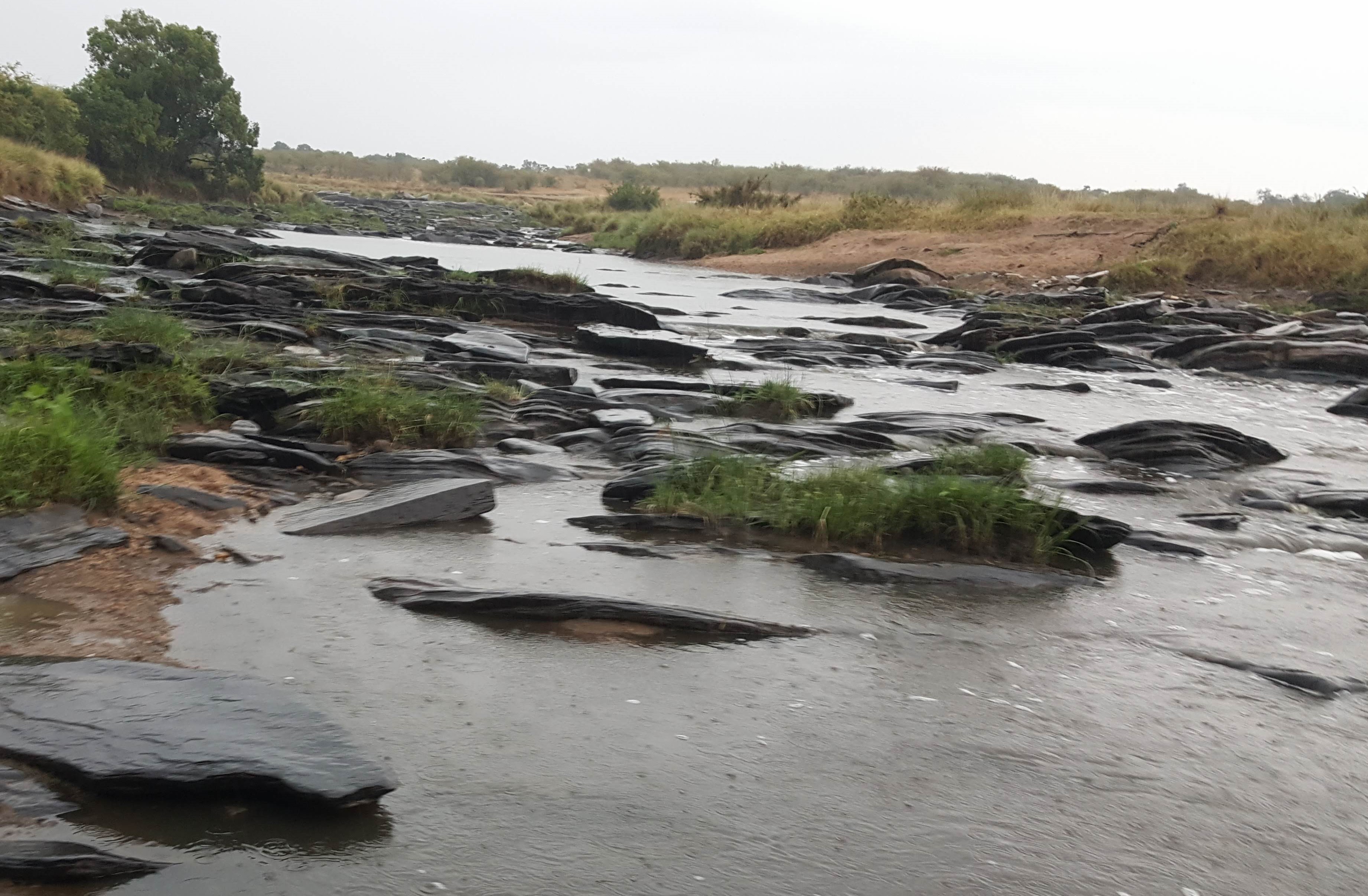
The place where Steven’s vehicle got stuck was more of a gulch than this spot, but this gives some idea of what we have to go through daily. We didn’t get any photos of the actual rescue because our vehicle was jostling so much that we all had to use both hands to hang on
Complete darkness fell as we made our way back to the camp, so Geoffrey was obliged to turn on the headlights. Those who drive within the reserve try to avoid subjecting wildlife to unnatural light, but they also don’t want to endanger their passengers by driving blind. It was nearly 7 p.m. by the time we reached the gate, and the rain showed no signs of letting up. Pam and Eric ran for their tent so they could change into dry clothes before dinner; we were glad that we had gone out that afternoon better prepared for wet weather. In the meantime, housekeepers had placed big umbrellas in each tent, so if anyone got wet on the way to dinner it was their own fault.
We arrived at the dining area soon enough to see staff members rushing to roll down and fasten the canvas walls that would protect us from water streaming off the canvas roof. We stayed dry through the meal, but no one felt like lingering very long at the table afterward. Moreover, the wifi in the lounge was acting wonky, so we hurried back to our tents and went to bed, hoping that we would be able to fall asleep despite the booming thunder.
Leave A Comment